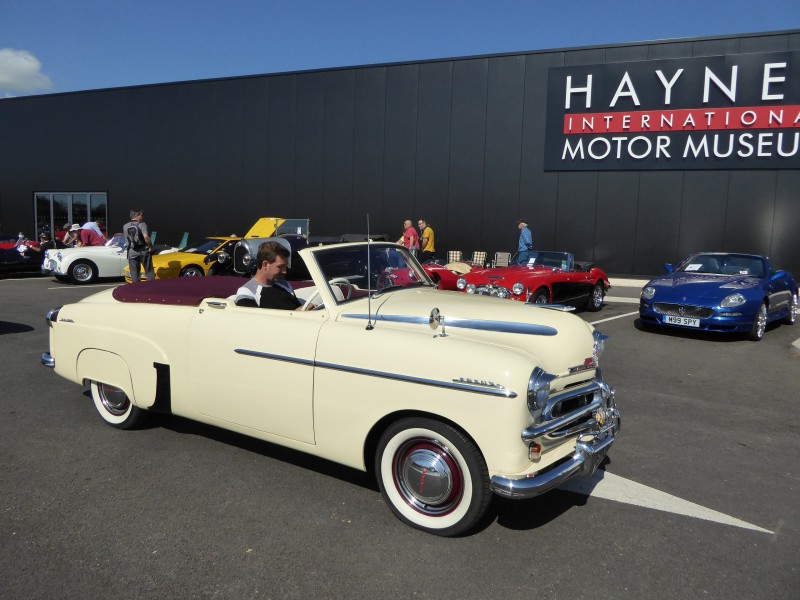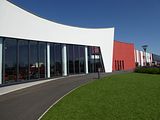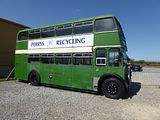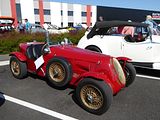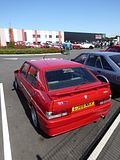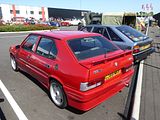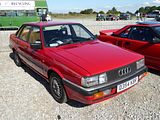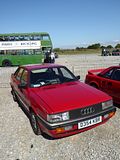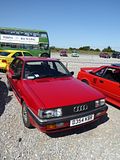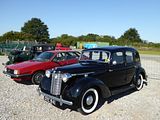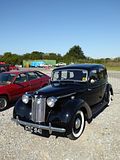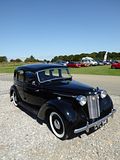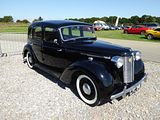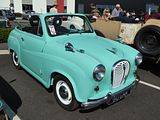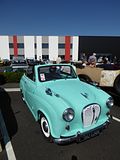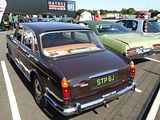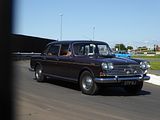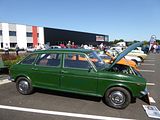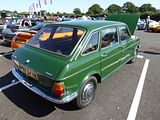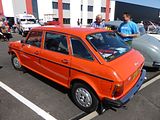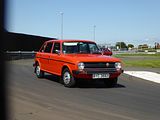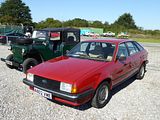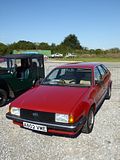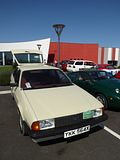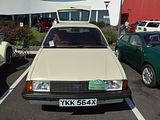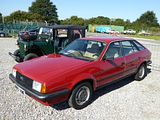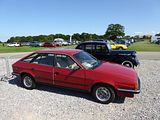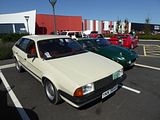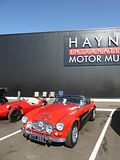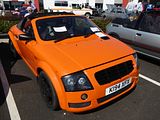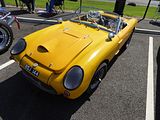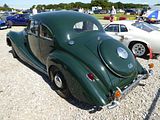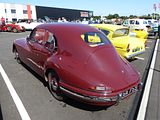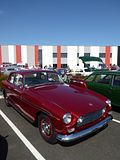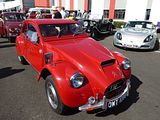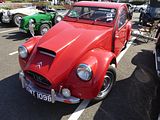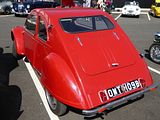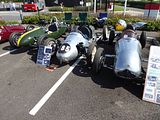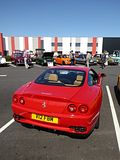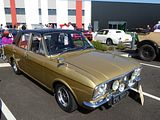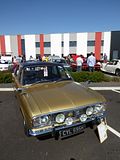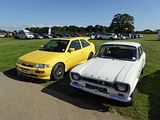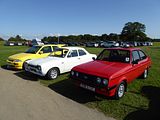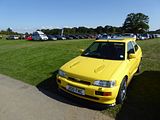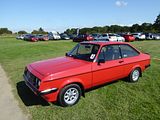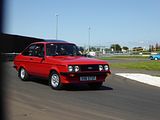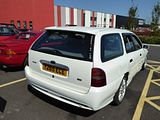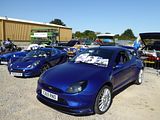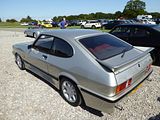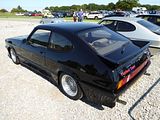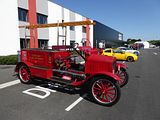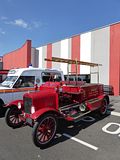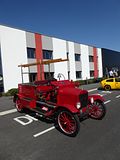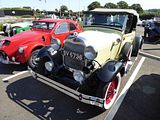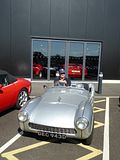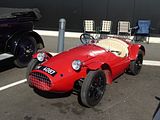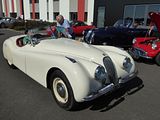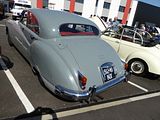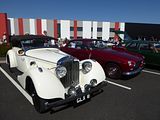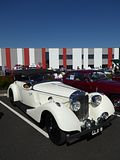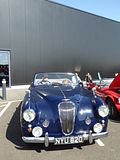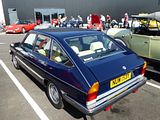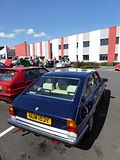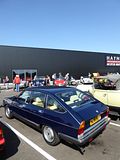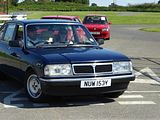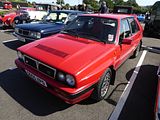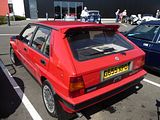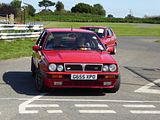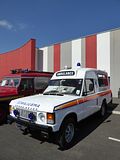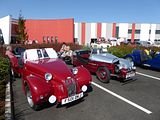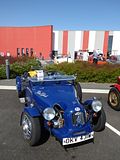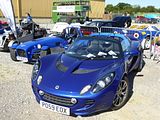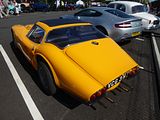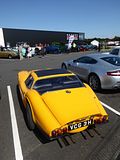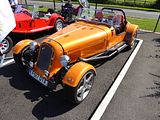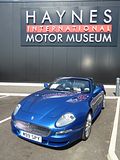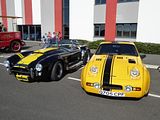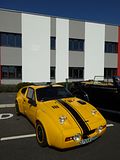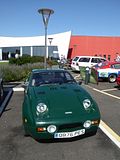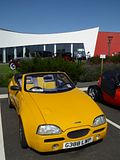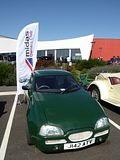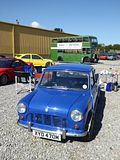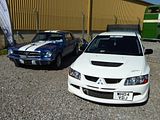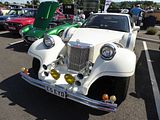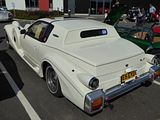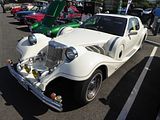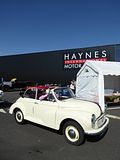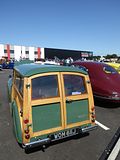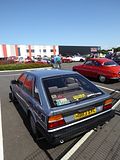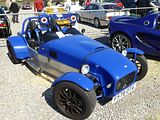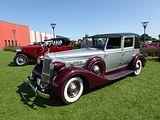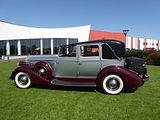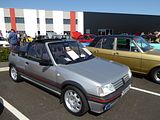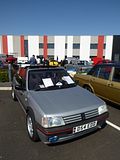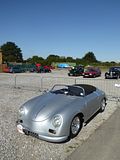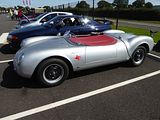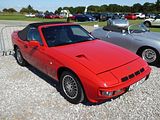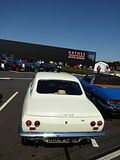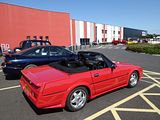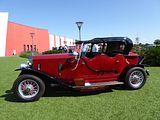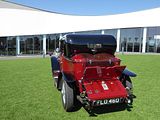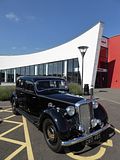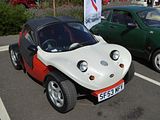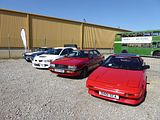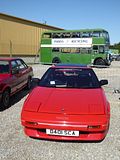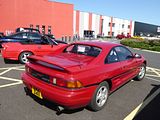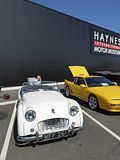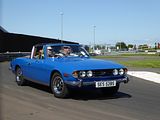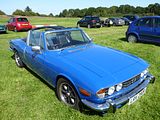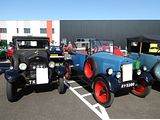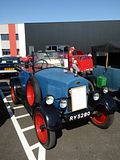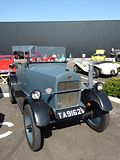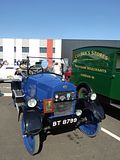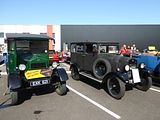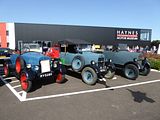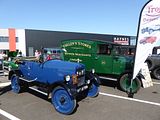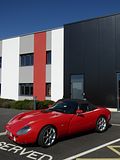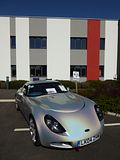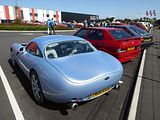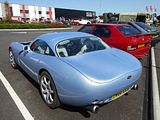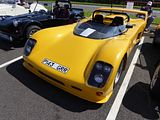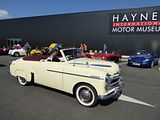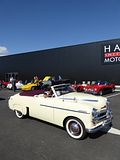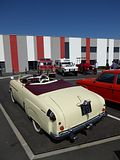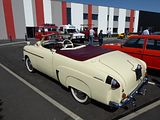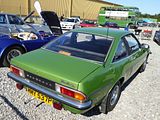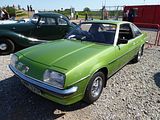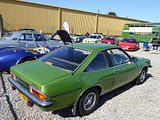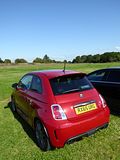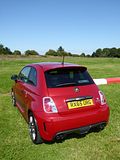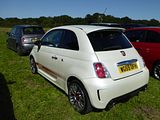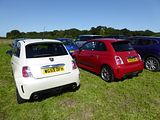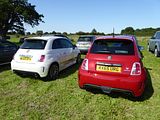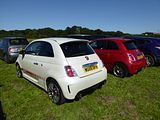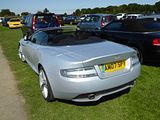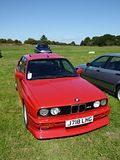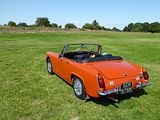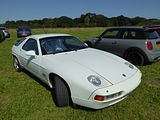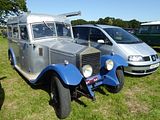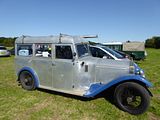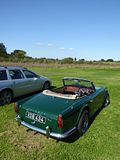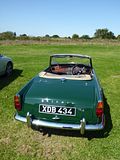If you go to a show that welcomes all manner of different classic cars, in the UK, you could probably come up with a list of 10 or 20 models which not only would be there, but probably there in some significant quantity. There’s nothing wrong with seeing lines of gleaming E Types and MGBs, Triumph TRs, Morris Minors, early Minis, VW Beetles and Austin Healeys, of course, and indeed I doubt I will ever tire of looking at such delights as these, seeing new versions of the same car, talking to their proud owners to learn something of the model’s history and seeing the cars in a new setting. But it is always nice to discover some rarity, the sort of car that perhaps was once a common sight on our roads, but which no-one really thought to preserve, so which is now more or less completely extinct, as well as those oddities that have you scratching your head, desperately looking for clues as to what it is that you are looking at. There are usually a handful of cars that come into these categories at any sizeable event, and often at smaller ones as well, but there’s an annual event held at the Haynes Museum which takes this genre as its raison d’etre. Called the “Rare Breeds”, the event has been held at the beginning of September for several years now, and it seems to be growing in size every year, with a record 160 cars entered in 2015. The day of the event was blessed with beautiful clear blue skies and warm sunshine which lasted all day, which was doubtless extra encouragement for people to attend. Cars that met the spirit of theme needed to be pre-registered, which gave them a parking spot in front of the museum, and, if the driver registered on the day, the chance to perform a few laps of the very small test circuit. Those who had not registered, or with a car which did not quite hit the theme were asked to park in the large field area around the back. It was worth doing a quick tour around this a couple of times during the day, as there were a number of interesting cars parked up, and I include these in the later part of this report. So here are the once familiar but now rare, the oddities and a few which you’ve probably not even heard of before, let alone seen.
THE RARE BREEDS
ALFA ROMEO
No question that this car qualifies as “rare”, as it is a one-off, Though, if you go to events in the Bristol area (and sometimes further afield), you may well have seen it, as owner David Roots takes it out lots during the course of a year, even braving the elements when it is cold or wet. For those who are wondering, it is an Alfa Special, designed as an homage to the 1935 8C Tipo C 35 Monoposto. Just eight of these cars, with a larger 3.8-litre version of the famous Jano designed engine, sharing no castings with the earlier blocks, were individually built for racing in five months, as raced by Scuderia Ferrari. The 3.8 produced 330 bhp at 5500 rpm, and had 320 lb·ft from 900 to 5500 rpm., and 15.5-inch drum brakes all round. Though not a match for the big Mercedes and Auto Union on the faster circuits, they came into their own on the tighter circuits and races. The last time one came up for sale, in September 2013, it was the former Scuderia Ferrari 8C 35, in which Tazio Nuvolari had won the 1936 Coppa Ciano, and it sold for £5.9 million; a new world record price for any Alfa Romeo. Given the rarity of the car and the way prices have rocketed in recent years, it is a fair guess that a genuine 8C like this would now have 8 digits in the price tag. Like many of us, David dreamed of owning a car like the original, but unlike most of us, he did the next best thing to paying the millions and decided to create his own. Back in 1989, somewhat deterred by the thought of the hours that could be spent lying underneath a rusty wreck at the side of the road, missing some obscure part that would need to be made specially. He decided to opt for a special combining retro styling with new bodywork and reasonably modern mechanics. A company called Classic Specials created that something, combining a bespoke chassis utilising MGB mechanics with a Lenham Healey bodyshell. Ten years later, in 1999, at the Castle Combe Classic Action Day he ‘blew’ the trusty B Series engine and that was the turning point which caused him to wonder if he could not actually design his own car. Many of us dream of doing this, but he actually decided to set about the task. Utilising the MG-Lenham chassis and Lenham Healey rear bodywork, the MG engine and gearbox were replaced with those from a 1969 Alfa Romeo 1750 GTV. Then a body had to be designed and constructed. This was done by making a buck from the aeroscreens forward, which was used to make a mould and moulding. Whilst it is not a precise rendering of the classic Tipo C, the result looks very professional, and the car always attracts attention wherever it is shown. I’ve seen the car, and indeed known David for a number of years now, but never before had the chance to ride in his very special creation. At this event, drivers were allowed to take a passenger, and it did not hesitate to accept his kind offer of a passenger ride as he had his turn on the circuit. Officially, cars were only supposed to get three or four very short laps, but as they were grouped by decade and there were few other cars from the same era, the organisers seemed to let us stay out far longer than we had anticipated. Speeds were not high and the circuit is basically just an oval, but it was enough to get a sensation of what the car would be like on the open road and why it is perhaps not the best machine to take on a long motorway journey. On a warm and sunny day like this, though, and at less than 60 mph, this was a great place in which to be a passenger. Thank You, David!
I also know the owner of the other Alfa in the display. This Alfa 33 belongs to Nick Grange, an inveterate attendee of almost as many events as me. Nick’s white Alfa 156 has barely made an appearance this year as, nice car though that is, the 33 is so much rarer. Believe it or not, the Alfa 33 is actually the best selling Alfa in history, with just under a million of them sold between 1983 and 1994, but precious few seem to have survived, as the car struggled to gain the affections of the enthusiasts in the way that the model’s predecessor, the AlfaSud, did. There were two distinct generations of the 33. The first ran from 1983 until 1990 and then a major facelift was applied with new front and rear styling to bring the looks more into line with the new 164. A mild facelift was applied to the first 905 series cars in late 1986. Exterior alterations were limited to clear indicator lens, wheel covers and alloy wheels of new design, the adoption of side skirts on all models, and a new front grille. Two-tone paint schemes were discontinued. There were more significant changes inside, with a more conventionally designed dashboard and steering wheel, which superseded the innovative moveable instrument binnacle. All 1.5 variants now had the 105 PS engine from the now discontinued 1.5 QV; a TI (Turismo Internazionale) trim level was exclusive to the front-wheel drive 1.5 hatchback. Changes were made to the suspension, brakes and gearbox, with closer-spaced ratios. A new 1,712 cc 116 bhp engine was introduced on the 1.7 Quadrifoglio Verde, which replaced the 1.5 QV. The 1.7 engine was developed from the 1.5 by enlarging bore and stroke; it also used new cylinder heads, incorporating hydraulic tappets. To cope with the increased power the new QV was equipped with vented front brake discs. The 1.7 QV looked close to its predecessor, but had lost the grey mid-body stripe and gained new alloy wheels, wind deflectors on the front windows, more pronounced side skirts and a rear body-colour spoiler on the boot lid. Inside it featured a leather-covered steering wheel, red carpets, and leatherette-backed sport seats upholstered in a grey/black/red chequered cloth. Diesel models were offered in some continental markets, but these were not sold in the UK, where only 1.5 and 1.7 Green Cloverleaf hatchback models were sold, as well as a market-specific 1.7 Sportwagon estate; all three were also available in “Veloce” versions, outfitted by Alfa Romeo GB with a colour-matching Zender body kit. Nick’s car is one of these.
AUDI
Definitely in the “these cars are all but extinct” category is this Audi 90. These were upmarket versions of the B2 generation Audi, launched in the autumn of 1984 as part of the facelifting of Audi’s mid-sized saloon car. Whereas the 80s all had four cylinder engines of 1.6 or 1.8 litre petrol and 1.6 Turbo Diesels, the 90s offered more power from their larger five cylinder engines, a 115 bhp 2 litre or the 136 bhp 2.2 litre (later enlarged to 2.3). Quattro all wheel drive transmission was an option on the larger engined model. The trim was noticeably more luxurious than in the 80s. The front end of the car was shared with the Coupe (the regular version of the urQuattro). The B2 generation Audi was a strong seller, with 1.680.146 models built between 1978 and the end of production, which was 1986 for the 80/90 and 1988 for the Coupe. The vast majority of these were 80s, of course (1.4 million of them), and even the Coupe sold more units – 169,047 – than the 90. With just over 105,500 sold, this was never a particularly common car when new. I can’t remember when I last saw one in the UK.
AUSTIN
Austin launched a new version of the 12, a large four-door family saloon, in August 1939, at a time when accelerated military spending was overflowing into a domestic consumer boom on the UK market. However, for Britain and her European allies 1939 was also the year when, in September, war broke out, and the British government switched the country’s manufacturing sector onto a war footing much more abruptly than was achieved in Germany. Most of the Midlands-based auto-making capacity, with its recently enhanced understanding of mass-producing metal goods, was switched to war supplies: this involved not merely aircraft manufacture but also (for some historians less glamorous) items such as tanks and Jerrycans. Austin’s auto-production capacity seems to have survived through the war better than that of competitors, and while new Austin 12s produced during the early 1940s were restricted to military and government use, the manufacturer was able to announce its postwar range in 1944, six months before the war in Europe ended. The line-up readied for the post-war period included the Austin 12 which was then produced until it was replaced in 1947 by the similar-sized but larger-engined Austin A70 Hampshire. For much of this period, however, it was provided only for military and government use. The car was presented as an all-new design. It shared a six-light (three windows on each side) profile with its predecessor, but was more streamlined. Standard fittings included a sliding roof, opening windscreen and leather upholstery. The bonnet was now one piece and hinged at the rear, rather than opening at the sides. The body was 3 inches longer than the earlier car, despite having a wheelbase that was (initially) 5.5 inches shorter. It was also 0.5-inch wider. A conventional chassis frame was retained, and the brakes were mechanical, with operation by a system of rods. Rigid beam axles were retained front and rear with conventional leaf springs. The 1939 Austin 12 inherited a 1535 cc sidevalve engine and four-speed gearbox from its predecessor, for which 40 bhp was claimed. Even by the standards of the day, it was considered by many to be underpowered. This issue was addressed in 1945 when Austin introduced the Austin 16, which was an Austin 12 fitted with the manufacturer’s first ohv engine, this having a displacement of 2199 cc. The extra power converted the car into what one commentator described as “a particularly lively proposition”, although by this time the less-than-lively Austin 12 had been in production for six years with the same body. By September 1945 numerous refinements and improvements had been implemented, presumably in response both to technical developments and materials shortages encountered. From the exterior the Austin 12 as announced in 1944 appears indistinguishable from the car announced in August 1939, and there was no attempt to highlight improvements introduced during the preceding five years. Nevertheless, the wheelbase had been reduced by 1.5 inches. A heater and radio were offered as extras. 8500 of them were made, and the survival rate is slightly better than smaller Austins of the period as they were slightly less rot prone. The car seen here was first registered in 1946.
This very neat looking A35 Convertible was a deserved prize winner on the day. Longbridge never offered an open version of the A35 or the earlier A30, though a prototype version was developed and this is part of the collection on show at Gaydon. Nonetheless, a number of conversions have been made, which look like the car was designed to be a rival to the popular Morris Minor Tourer. The A35 model was launched in 1956 and although visually very similar to the A30 of 1952, it included a number of improvements which significantly improved the car, including a more powerful 34 bhp 948cc engine replacing the earlier 803cc unit. Outside, there was a larger rear window aperture and a painted front grille, with chrome horse-shoe surround, instead of the chrome grille featured on the A30. The semaphore turn-signal indicators were replaced with present-day front- and rear-mounted flashing lights. A slightly easier to operate remote-control gear-change was provided. Much of the improved performance was a result of different gearbox ratios. The A30 had the first three ratios close together then a big gap to top (fourth gear). The A35 ratios were better spaced and gave a higher speed in third gear. Like the A30, the A35 was offered as a two- or four-door saloon or two-door “Countryman” estate and also as a van. The latter model continued in production through to 1968. A rare coupe utility (pickup) version was also produced in 1956, with just 477 sold. The A35 passenger cars were replaced by the new body shape A40 Farina models in 1959 but the estate car version continued until 1962 and van until 1968.
I’ve seen this beautifully presented Austin 3 Litre at this event in previous years. It is a rare car, though, so well worth another look. The 3 Litre sat at the top of the non-premium part of the British Leyland range, acting as a replacement not just for the Austin Westminster, but also the Wolseley 6/110 and even the Vanden Plas Princess 3 litre. It was premiered at the 1967 Earls Court Motor Show, but production did not start until well into 1968,. by which the model had been slightly restyled with twin circular headlights replacing the oblong units of the launch car. Sharing the centre body section with the established ADO17 Austin/Morris 1800 range, the car was elongated at both ends, providing a much larger boot at the back, and space for the 3 litre inline 6 cylinder C Series engine to be installed in the front. Unlike the 1800cc cars, this one was rear wheel drive. Initial reviews were luke warm, at best, and sales were sluggish. They did not get any better as the months went by, and production ceased in 1971 after just 8600 cars had been made. Few have survived, as many met their fate on the banger racing circuit where the immense strength of the body was a real asset, but those which have – and a couple of them were on show here – are thought of more fondly now than they were when new. Martin Buckley, well known for his love of slightly off-beat classics is a particular fan.
Although it also failed to achieve its full potential, when new, the Maxi sold in decent quantities in the UK, even if it struggled to find favour beyond these shores. Now, though, there are few survivors, and the car is far less commonly seen than other BL Models of the period. But here, there were two of them: a 1750HL and a Series 2 car, the short-lived facelift applied for the last few months of production. Developed in the mid 60s, the ADO15 was intended to plug the gap between the ADO17 Austin/Morris 1800 cars and the volume selling 1100/1300 cars, providing BL with a much needed competitor for the Mark 2 Cortina, which, along with the Escort had helped to grow market share in the UK, mostly at BL’s expense. Long in gestation, as was not uncommon at the time, the new car eventually made its debut as the Maxi on 1st May 1969. Promoted as the “5 of everything” car, it had 5 doors, 5 gears (both unusual in the market in those days) as well as 5 seats. It also featured a brand new engine, the 1500cc E Series, which was not really up to the task. It was also saddled with what by common consent was one of the most recalcitrant gearchanges ever inflicted on a production car, with a lever operated by rods which had to be carefully lined up to persuade the next gear to engage. That aside, the car had huge potential and a vast amount of space in a footprint that measures less than 14 feet in length. A revised version was launched in the autumn of 1970, with a cable operated gearchange and the option of a more powerful and torquey 1750cc engine. Sadly, apart from adding the twin carburettor HLS version to the range in 1972, that was about all that BL did to the design in the next 10 years. Talk about starving a model of its full potential. The last few cars were branded Series 2 and had new bumpers and interior trim, but that was about it. What a wasted opportunity!
There were 2 examples of the short-lived Ambassador here. Many will tell you that this is the car that the Princess should always have been from launch, that is a hatchback. It is still not clear why Harris Mann’s boldly styled ADO71 car went into production with a small boot opening instead of the more useful large rear tailgate. By the time the Ambassador was launched in March 1982, the Princess had been on sale for 7 years, and so even a comprehensive facelift, which is what this change was – despite the fact that all the body panels apart from the front door skins were apparently new – could not really hope to compete against the recently launched all-new Vauxhall Cavalier or even Ford’ Sierra which would arrive later in the year. The Ambassador did have roominess on its side, with a lot of space for rear passengers, but it also had BL Build Quality, and some of the cars proved to be not particularly reliable. The 2.2 litre 6 cylinder engine was not offered, meaning that Ambassadors only came with the O Series engine, in 1700 and 2000cc guise. Top spec models, the HLS and Vanden Plas had a twin carburettor engine, but even these did not have a 5 speed gearbox, which was fast becoming a necessity for cars in this class. That coupled with the fact that the cars were not very inspiring to drive meant that despite the fact that the top spec cars were quite well equipped and nicely trimmed inside, the model’s appeal was limited. The Ambassador was only ever going to have a short life, as it was deleted once the Austin Montego hit the market in April 1984. Although engineered for left and right hand drive, only right hand drive models went into production, so the car was only sold in the UK. 43,427 were built in the two years which it was available, of which only a handful are still on the road, with a few more in SORN status.
AUSTIN HEALEY
This is a very late model 3000 BJ8, registered in 1967, the last year of production.
BANHAM
When I first saw this car, I just thought “nice first generation Audi TT” to myself, But then I looked again, and realised that it was not. It was far too small, for a start. My reaction is, according to the car’s owner, not unusual., It’s a Banham X99, and believe it or not, it is based on a Rover Metro. So, yes, it is quite a bit smaller than the TT whose looks it does resemble. It is not the only Banham product, as a chat with the owner and some subsequent research has elicited. Banham Conversions was a maker of kit cars from the late 1970s until 2004. The company was founded by Paul Banham who started off building convertible conversions on commission. He made convertible versions of the Ferrari 400, Aston Martin DBS and V8, and the Rolls-Royce Corniche. By the 1980s, he was marketing a kit to rebody the Jaguar XJS. He also offered convertible conversions for the XJS and Jaguar XJ6. The Banham Spyder (since the 1980s) was based on the Skoda Estelle and Skoda Rapid and was inspired by the Porsche 550 of James Dean fame. In the 1990s Paul Banham also bought the original bodywork tooling for the Ford RS200 and used it to make kits based on the Austin Maestro (preferably the MG Maestro Turbo version). Being front wheel drive it offered both a rear seat and a boot where the engine was in the original RS200. In the late 1990s, Banham moved into making Rover based kit cars. Kits based on the Mini were the Roadster, which converted a Mini into a two seat roadster and the Sprint, inspired by the Austin-Healey Sprite. Kits based on the Rover Metro resulted in the Banham X99, like this one, which actually predates the production Audi TT, taking its inspiration from the concept version which was shown two years before Audi turned the concept into reality. After some intervention from VAG over the origin of its design, Banham’s offering had to be revised slightly, resulting in the Banham X21, which looked a bit like a Nissan Figaro and Audi TT. Other Metro based offerings were: the Banham BAT (based on the X21, but with a futuristic styling); the Banham New Speedster, inspired by the Porsche 356 Speedster; the Tiger, inspired by the Sunbeam Tiger; and the Banham Superbug, a modern interpretation of the Mini Moke. The company was sold in 2004 to Rally Sport Replicas Ltd who sought to create new chassis for the designs, but they ceased trading in mid-2005. The New Speedster was excluded from the sale, and the design and tooling were was sold to 356 Sports during 2006. That company later ceased trading.
BEACH BUGGY
BERKELEY
BRISTOL
There were three Bristol cars here, showing the evolution of the body styling from the first 400 model through the two shapes which are most commonly thought of as “that’s a Bristol”, the 403 of the 1950s and the later 410 of the 1960s and first half of the 70s.
The 400 was the first automotive product of the British Bristol Aeroplane Company. After World War II, BAC decided to diversify and formed a car division, which would later be the Bristol Cars company in its own right. BAC subsequently acquired a licence from Frazer Nash to build BMW models. Bristol chose to base its first model on the best features of two outstanding pre-war BMWs, namely the 328’s engine, and the 326’s frame. These were covered with a neat mainly steel body but with aluminium bonnet, door and boot skins and inspired by the BMW 327’s. The Bristol 400 featured a slightly modified version of BMW’s six-cylinder pushrod engine of 1,971 cc. This engine, considered advanced for its time due to its hemispherical combustion chambers and very short inlet and exhaust ports, developed 80 hp at 4,500 rpm and could carry the 400 to a top speed of around 92 mph with acceleration to match. In order to maintain a hemispherical combustion chamber, the valves had to be positioned at an angle to the head. In order to drive both sets of valves from a single camshaft, the Bristol engine used a system of rods, followers and bell-cranks to drive the valves on the far side of the engine from the camshaft. Owners soon found that setting and maintaining the numerous clearances in the system was difficult but vital to keep the engine in tune. The gearbox was a four-speed manual with synchromesh on the upper three ratios and a freewheel on first. The 400 was the only Bristol to be fitted with a steel and aluminium skin, and had all flat glass, but for the curved rear window, glazed in perspex, which was available to specification with a top hinge. This feature was very welcome on warmer climate export markets, where the sliding door windows provided only marginal ventilation to the passengers. The 400 featured independent front suspension with a transverse leaf spring and a live axle, located by an A-bracket over the differential case and longitudinal torsion bars with transverse arms and brackets at the rear. It featured a lengthy 114 inch wheelbase and a very BMW-like grille at the front of its long bonnet. The passenger area was very short, with the spare tyre mounted inside the boot on the first cars, but eventually mounted on the rear hinged boot lid, inside an aluminium cover. The 400 was produced for 3 years and 487 units were made. It was replaced by the 401.
The Bristol 403 was produced between 1953 and 1955, the third of the eventual five series of Bristols powered by the BMW-derived pushrod straight-six engine. It replaced both the Bristol 401 and 402 in 1953 and continued in production for two years. The 403 retained much the same styling as the 401, but featured many mechanical improvements compared to that model. The 1971 cc six-cylinder engine was modified through the use of bigger valves and larger main bearings with a diameter of 54 mm as against 51 mm on the 400 and 401, which increased the power output to 100 hp as against 85 hp in the 401. The acceleration was markedly improved: the 403 could reach 60 mph in 13.4 seconds as against 16.4 seconds for the 401. The 403 had a top speed of 104 mph. To cope with this increased power, an anti-roll bar was fitted on the front suspension and improved drum brakes known as “Alfins” (Aluminum finned) were fitted. Early models had them on all wheels, but Bristol thought the car was over-braked and they were thus restricted to the front wheels on later 403s. The 403 was the last Bristol to feature a BMW-style radiator grille. It is also noteworthy for having two extra headlamps at the side, almost pre-dating the adoption of the four-headlamp layout in larger cars (Bristol themselves adopted it with the 411 in the late 1960s).
Launched in 1968, the Bristol 410 was the fourth series of Chrysler V8-engined models, and the last Bristol to use the 5.2 litre engine originally found in the Bristol 407. With the 410, Bristol aimed for a more aerodynamic approach than that found on their previous five series dating back to the 405. The styling improvements were relatively minor but every one of them was aimed to make for a more curved appearance. The most noteworthy change was that the front headlamps were fully faired into the wings of the car rather than protruding outwards as on previous models. As in every Bristol saloon since the 404, a compartment accessed via a hinged panel between the front of the driver’s door and the rear of the front wheel arch housed the battery, fuse panel, windscreen wiper motor and brake servos.[2] A similar panel on the other side of the car housed the spare wheel and jack. There were also 15 inch wheels as against the 16 inch size found on previous Bristols, and the disc braking system dating back to the 406 was revised for the first time since then, with a greatly updated system of braking circuits being introduced. Internally, Bristol, like Chrysler before them, by then had felt that the safety problems of push-button automatic transmission were too difficult to counter and thus they shifted to a more conventional lever mounted between the two front seats.82 of them were made before the longer-running 411 was introduced as a replacement.
CITROEN
This was definitely one of the more intriguing cars of the day. It is a 2CV Dragonet Coupe. This one is a replica made in 2014 using a steel body and a donor car from the 1960s, but the original Dragonet models date back to the mid 1950s, and they had glassfibre bodies. They were conceived as a possible vehicle for rally-cross. There’s not much information about them that I found online, though it would seem that some of the model makers have produced small scale versions in recent years.
COOPER and 500cc CARS
There were a number of the diminutive 500cc race cars here, two of the ones depicted are Coopers and the other is the Creamer Special, a car which I last saw at Chateau Impney in the summer. There’s still a very avid following for enthusiasts of this little cars which really got underway in 1946 as a way for “impecunious enthusiasts” to go motor racing using 500 cc motorbike engines instead of the larger capacity engines that prevailed prior to the war. The idea caught on and was adopted as a new Formula 3 in 1950. Well known names raced in 500s including Stirling Moss, Ken Tyrrell, Ivor Bueb, Jim Russell, Les Leston, Peter Collins, Don Parker, Stuart Lewis-Evans and Bernie Ecclestone, and at famous locations like Shelsley Walsh, Mallory Park, and Silverstone. Dozens and dozens of different marques and one-offs were involved at the time, and even now you will come across quite a diversity of these racers if you attend an event where they are participating.
ERF
Fire Tender
FERRARI
Sole Ferrari here was a 550 Maranello, the elegant V12 grand tourer that Ferrari produced from 1996 until 2006.
FIBERFAB
I’ve seen this car at a couple of previous events at Haynes, so this time I knew what it was. First time, I had no clue, as it is not something I recall ever reading about it in any publication either when it was new or more recently. Luckily, the owner leaves an information sheet in the car to enlighten everyone. It is called the FT Bonito. This particular car was found in 1999, following a 12 year lay up. It is based on a Beetle chassis, but has a 1.8 litre 16 valve engine behind the driver, and, as is not uncommon for cars like this, parts from a number of other cars in its parentage. Once restored, this Bonito has been used extensively for racing. Having seen it the first time, I did some research online and learned a bit more about the company who originally created it, Fiberfab. This was a kit car manufacturer founded by Warren “Bud” Goodwin in 1964. Goodwin’s earlier company, Sports Car Engineering had manufactured Microplas Mistral bodies under licence and sold them as the Spyder. Fiberfab started building street rod parts and body panels for Mustangs before moving on to kit cars. It was sold in 1983 to Classic Motor Carriages. This company was forced to close in 1994 after the Florida Attorney General’s Office filed suit against it on behalf of several hundred of its customers. It agreed to pay $2.5 million in compensation. At the same time as the case was proceeding, a new company, Auto Resolutions, was set up by the owner George Levin to continue making Classic Motor Carriages vehicles trading under the name Street Beasts. Street Beasts closed its business in 2010 and auctioned off its plant, moulds, and machinery. Classic Motor Carriages (CMC) continued to use the Fiberfab brand after 1983 although those cars were built using CMC moulds. During this time a number of different models were produced, with a variety of different donor vehicles.
FORD
When When Ford unveiled the 1600E version of the humble Mark 2 Cortina, it pulled off the biggest trick going: it took a mass-produced car and made it a statement of individuality. These days we take it for granted that every middle-of-the-road family car will have a sporty and a luxurious but affordable sibling, but back in the mid 60s, this was not the case. if you wanted something special, you had to go to a different model, or even a different marque. And that was costly. Too costly for most people, So BMW 1600s, Alfa Romeo Giulias and Lancia Fulvias were out of reach and remained a rare sight on our roads. But Ford’s marketing department figured that there was a gap here in the market that they could fill, and in the autumn of 1967, they launched their offering. Noting that there were plenty of people who were trying to make their cars that bit special by adding extra dials to the dashboard, and bolting on an after-market exhaust, Ford decided to do the job properly, They took the best-selling, most mass-produced car in the world and made it a statement of individuality. The really clever bit, of course, was that the ‘executive’ Cortina wasn’t just a Halford’s special. No, the new 1600E was the best handling Cortina going, thanks to a trick suspension and warmed over engine. It was the missing link between the inappropriately badged De Luxe and the awe-inspiring, marriage-destroying Mk II Lotus Cortina. It was, in short, genius. No-one saw the 1600E coming when the Mk II Cortina was unveiled in October 1966 – not even Ford. For once, the boys at Dagenham had taken their eye off the ball and were losing crucial company car sales. They were being lost to Rover and Triumph’s ‘executive’ 2000 models, launched in the autumn of 1963, so now well established in the market, and seen as highly desirable products which were a cut above a Cortina. Ford first reaction had been with the 2.6-litre Zodiac Executive and they followed through with the Corsair 2000E. The idea was simple: take one established model and give it a vinyl roof, a wooden dash and plusher seats, and decorate with the letter ‘E’ on the end of its badge – plus a few hundred quid extra on the sticker price. But someone somewhere got a bit carried away and modified the sluggish gearbox – with its horribly low second gear – by fitting sportier, closer ratios. It was nothing that modifiers hadn’t been doing already, but it finally meant that Ford had built the Corsair everyone wanted. Its success was instant and is the sole reason for the 1600E Cortina. The very first prototype 3036E (as it was known to the design department), was developed in spring 1967 and used Cortina GT mechanicals, Lotus Cortina suspension and wheels – but the switch to those distinctive Rostyles was the moment it came to life. Best of all, Ford could move quickly on its new E model – all of the parts were in common use and were proven performers. The Ford Cortina 1600E has been called many things, mainly a four-door GT with Lotus Cortina suspension in a party frock – but that’s a bit wide of the mark. Based on a Cortina GT, it benefited from the re-designed Kent engine that now boasted a crossflow cylinder head, increased capacity and a longer stroke. The hike from 78bhp to 88bhp meant that the new 1600E was a near-100mph car.Underneath the four-door saloon bodyshell was a mix of Cortina GT and Lotus Cortina. The back axle and engine were pure 1600GT (literally in the case of the rocker cover, which still carried the 1600GT legend) coupled to the uprated ’box from the 2000E. The new model sat on the shorter front struts, lowered rear leaf spring suspension and stiffer spring and damper settings from the Mk II Lotus Cortina. The official Ford parts book listed several different sets of springs and dampers in the time that the 1600E was in production – some of which were Lotus Cortina, and some of which were not. Most examples these days seem to use the Lotus settings for maximum squat and better handling. The cars were easy to identify out on the road, with the black, Lotus Cortina-type grille, extra Wipac driving lamps and automatic reversing lamps. Inside, the instrument layout changed little from the GT – but the matching speedo and rev counter dials were now tucked away behind the new steering wheel (complete with light alloy spokes, circular holes to reduce weight and a padded faux-leather rim). All of this wouldn’t have been worth a penny if Ford had got the price wrong. But, seriously, when does Ford ever make that mistake? Sure enough, the 1600E was right on the money at £982 – more expensive than the £890 1600GT and cheaper than the £1098 Lotus Cortina. On the road, it was a lot livelier than other Mk II Cortinas, with the 1.6-litre crossflow happily pulling right through the rev range thanks to its longer stroke. And, thanks to the sportier gearbox, you can really make the most of it. But it was the cornering that really delighted with this car – confidence-inspiring, with the quick steering offering you plenty of feedback. Several road tests complained about the 1600E’s harsh ride, but few owners seemed to care. Unlike so many fancy models that start brightly and fade away, the 1600E was a match winner, with production figures growing steadily year on year. In fact, the two highest months of production were June and July 1970 – shortly before the entire Mk II range was replaced by the coke-bottle styled Mk III of Life on Mars fame. All in all, 58,582 1600Es were made from a total Mk II Cortina run of 1,159,389. Ford, believing the E phenomenon had passed, never replaced it, leaving enthusiasts to make do with a new 2.0-litre Pinto engined car available in sporty(ish) GT and luxury GXL trim. Eventually, there was a poor-handling 2000E, but by then the moment really had gone… and the 1600E’s place in Ford folklore was assured.
Just as legendary in Ford’s history, of course, is the Escort, and a trio of sporting Escort models were parked up on the side of the museum, showing the evolution of Ford’s ever-popular family car in its most sporting guise. There were no examples of the Mark 3, the first of the front wheel drive models, but the other three generations were represented, and the three models on display were the top model of each generation. For the Mark 1, that meant a Twin Cam, the short-lived and rather pricey car which had the Lotus 1558cc unit under the bonnet in the same way as the Lotus Cortina models, did. Top of the Mark 2 range was the RS2000, which was visually distinguished from lesser models by its “shovel nose” front end with four round headlights, as well as by the mechanical changes which gave it a 2 litre Pinto engine, something not offered in the cooking versions of the car. Final car was a Mark 4 RS Cosworth, the car which was to some extent responsible for the demise of the Hot Hatch in the early 1990s. Ferocious performance in unskilled hands, as well as the fact that they were easy to steal (and frequently were) meant that insurance premiums for the car rocketed. making them unaffordable. A certain Jeremy Clarkson, early in his career, found out that the insurance was going to cost around £25,000 a year, which was more than the car cost to buy. Now, of course, it is seen as a classic and the only truly desirable version of the Mark 4 Escort, a model which in lesser guise was round condemned at launch as simply not good enough in just about every respect. Ford did their best and later cars were better, but the RS was the only truly bright spot in that period of the Blue Oval’s life.
After the dreadful press for the Mark 4 Escort, a car where the accountants over-ruled the engineers, Ford learned their lesson, and the proverbial pendulum swung well in favour of the engineers, led by one Richard Parry Jones, who made sure that successive Fords of the 1990s were genuinely good to drive, even in the mundane non-sporting models. First manifestation of this was in the original Mondeo, launched in early 1993. A revelation in just about every respect compared to the Sierra, which had never been a particularly good car, especially in the lower end models, saddled with desperately uncompetitive and rough engines, the Mondeo fixed everything: looks, interior space, build quality, refined and potent new engines and class leading steering and handling. The 136 bhp 2 litre cars offered at launch were pretty brisk, but it was not long before Ford introduced a faster model, the 2.5 litre V6 in the summer of 1994. This engine was based on the unit used in the American market version of the car, the Ford Contour. It produced 170 bp and was smooth in operation but also rather thirsty. It was the basis for a more sporting model which would appear in 1997, though, and with the launch of Ford’s ST performance branding. This was the Mondeo ST24, The power of the engine stayed at 170bhp, but the ST featured unique cabin trim, with half leather seats, 16 inch alloy wheels (that were originally only available on a Ghia X Estate, and a full Rally Sport Appearance Pack body kit as standard, The bodykit option was listed as a delete option for those that did not want it fitted as standard. This was later replaced by the Limited Edition ST200 in 1999, featuring an SVT version of the V6 Duratec with a power output of 200bhp. This engine made the ST200 go from standing to 60 mph in around 7.7 seconds, and reach a maximum speed of 151 mph. Tuning included a different throttle body, cams, flywheel, and upper manifold to name a few of the changes. The ST200 also had even harder sports suspension than the ST24, and came with half-leather Recaro sports bucket-seats, full-leather being available as a cost option. The ST200 was released to the public in Imperial Blue colour, Moondust Silver and a very limited number in white, mainly for use by the police. Although neither of these ST models ever sold in high numbers, the marketing was important to Ford, as it was an introduction to the ST range as a sportier side to the full range, especially significant as apart from the Focus RS, both the XR and RS model ranges were phased out during the 1990s.. There are not that many surviving Mark 1 Mondeos of any type these days, so it was nice to see an ST200 here, in the particularly rare Estate bodystyle.
Ford launched the Puma in 1997. Based on the Fiesta, but using new Yamaha-designed eninges, the Puma was a small sporting Coupe which was intended to see off the Vauxhall Tigra (which it did, with consummate ease!) and to fill the gap in the market left by the reduction in the number of hot hatches offered. The first cars came with a choice of Ford’s 1.4 or 1.6 litre engines, which made them moderately brisk, but it was really the steering and handling which made them such a joy to drive. Excitement mounted though as rumours of an RS version started to circulate. When it was launched, at the 1999 Geneva Show, it did not bear RS badges but was called the Racing Puma. ] At the time, Ford were keen to stress that this was no mere styling job and the idea was to transfer the know-how and technology learned directly from Ford Puma race and rally programmes to a road car. It was created by the Ford Rally specialist team at Boreham, and was produced by Tickford. For the Racing Puma, Ford partnered with Alcon Design to produce a 4-Piston Motorsport braking system. The Alcon Racing Front Brake callipers use 11.6 inch discs. These brakes are one of the defining attributes of the Racing Puma and they contribute significantly to enabling the standard 1,174 kg (2,588 lb) car to pull a substantial 1.1g of braking force in the dry (this is the same braking g-forces performance as a Lamborghini Gallardo!). This compares well to the normal Puma’s ability to achieve 0.7g on regular, smaller, 10.2 inch brake discs and callipers. The brake callipers themselves, being derived from a racing set-up, do not come fitted with any protective rubber boots which prevent brake dust and debris from coming into contact with the brake pistons. This means the brakes should be serviced regularly (fully dismantled and properly cleaned) to maintain efficiency. Furthermore the inner portions of the calliper were unpainted aluminium, and are susceptible to corrosion. The bodywork was beefed up with wider lightweight aluminium front and steel rear overhangs, these covered a substantially widened track at both the front and rear requiring longer drive shafts unique to the Racing Puma. A front aerodynamic air splitter and modified wider front bumper with sports grill. The wheels are Speedline Corse Turini alloys; 17″ x 7.5 and use 215/40 17 tyres. This increases the width from 1674mm to 1770mm. The S1600 rally Puma is just 35mm wider than this. The Racing Puma’s suspension was developed and honed by Ford’s specialist division at Boreham, Essex and the cars monocoque shell was originally designed to be Ford’s WRC entrant. Stig Blomqvist spent months fine tuning a car’s handling to ensure its chassis dynamics where perfected. The wider track, uprated springs, dampers and special geometry settings refined the cars cornering poise to another level beyond the standard cars already excellent handling. The upshot of the improved chassis finesse was a bias towards tracks and hence the car has a very firm ride. The standard IB5 gearbox was strengthened on the Racing Puma in comparison to the standard models. It contains modified shafts which have been shot peened to withstand the extra load placed upon them. This allowed a revised Power-train Control Module software to be used, allowing more power and torque to be used in lower gears. Additionally, Ford Racing offered an optional limited slip differential to enhance handling even further, only 80 customer cars actually came equipped with an LSD from factory, but since then subsequent owners have been known to retrofit this option. Sparco were commissioned to provide high-grip bucket seats for improved driver control in cornering situations. The blue Alcantara trim used on the seats and steering wheel provided improved grip over other material types. The door cards, rear seats, and rear interior were also trimmed with the same material, and the front seats where embroidered with the Ford Racing emblem. The original design remit was to achieve 180 bhp using a 1.7-litre Zetec SE equipped with a turbocharger. However, due to spiralling project costs, this was not achieved and eventually the Racing Puma engineers where forced to keep their changes within a normally aspirated engine. The majority of the engine remained unchanged from the 1.7 Zetec SE used in the standard Puma. Only the camshafts, air intake (with the unique edition number engraved on it), a specially tuned complete exhaust system by Janspeed, and a revised engine management software helped to increase power by 30 hp, reducing the 0-62 mph time to 7.8 seconds. All Racing Pumas left the factory painted metallic Imperial Blue to signify their special racing edition status. This colour was only used by Ford on a select range of cars such as the Ford Escort Cosworth and Mk.1 Ford Focus RS edition models. The colour was not available on the regular Pumas in the UK market. The strictly limited production run was initially pencilled to run for 1000 units, with 500 destined for the German market, and 500 for the UK. In the end, only the 500 destined for the UK market were produced and sold. Less than half of the 500 cars were actually sold directly to customers, with the vehicle’s high price (£23,000 when new) often cited as a reason, as rival performance cars such as the Subaru Impreza, with an additional 50+ bhp four-wheel-drive and a rallying pedigree were being offered for a only £21,000. The lower than anticipated demand had Ford offering Racing Pumas to senior managers through their MRC scheme, which enabled cars to continue being registered and converted. The lack of demand when brand new has actually paid off in the longer-term, as the rarity of the Racing Puma has allowed it to maintain an increased value over the standard Puma.
Ford’s Coupe offering in the years before the Puma had been the Capri. Sold between 1969 and 1986, it was a popular car, combining style with the proven mechanicals of the Cortina, which kept the price down to affordable levels. Even the top of the range 3 litre and later 2.8 litre cars were within reach of many people. However, this did not stop Ford looking to see if there was potential to produce something that bit more exclusive and in the autumn of 1983, they announced a venture with Newport Pagnell based coachbuilder Tickford, creating the Tickford Capri, It used a turbocharged 2.8 Injection Cologne engine which developed 205 bhp, allowing it to reach 60 miles per hour in 6.7 seconds and 100 miles per hour in 13.4 seconds, topping out at 137 miles per hour. This version also featured a luxury interior with optional full leather retrim and Wilton carpeting and headlining, a large rear spoiler, a colour-coded front grille, deeper bumpers and ‘one off’ bodykit designed by Simon Saunders, later of KAT Designs and now designer of the Ariel Atom. Rear disc brakes were standard and there were numerous other suspension modifications. This model was essentially rebuilt by hand by Tickford at approximately 200 hours per car. One problem was the relative price difference to the standard Capri 2.9 Injection, with the Tickford version costing twice as much. An idea like this would probably be a lot easier to sell now than it was then, where the price put too many people off, with fewer than 100 units being sold. Three of them were on display here.
There were a couple of US and pre-war Fords here, too. Older of the pair was a Model T converted for service as a Fire Truck and there was also an example of the “Tin Lizzie”‘s successor, the Model A.
HAMBLIN
I recognised this duo as they were present at the event last year, otherwise, I would have been stumped. Surprisingly, the silver car is older in design than the red one. It is a Hamblin DeLuxe. Sid Hamblin had been running his panel beating business for a number of years when, in late 1956, with some time on his hands he designed a body shell that could be used on an Austin Seven chassis. In April 1957 he launched what was to become known as the Hamblin Deluxe. Made of aluminium and although designed specifically for the later 6’9″ wheelbase chassis, Sid was quite happy to modify a body to suit a 6’3″ or a Ford 7’4″ chassis. No price was ever advertised, but early adds quoted that it would compare favourably with those fibreglass bodies now available. Supplied as a kit of 19 panels, all flanges were pre-drilled and could be bolted together in an evening and only needed flat floors and a backrest to finish the body. The new bodies could be viewed at Super Accessories in Bromley, a well known Mecca for the specials enthusiast. But even this high exposure could not help with the slow sales and from September 1957 the body was no longer advertised for sale. Only about a dozen of these kits were sold.
The other car was a Hamblin de Luxe Special Cadet, and was made in 1958. These were also built on the Austin 7 chassis, a ready supply of which were available for the price of a pint of beer in “make-do and mend” post-war Britain, where the body had worn out, but the chassis could be given a new lease of life. Advertised as the cheapest fibreglass shell on the market and priced at £34.10s, it is likely that few were sold to this specification. For this price the purchaser would have to make and bond in his own front mounting, cut and fit his own bonnet and doors, trim off all the flash from around the cockpit and grill etc and still have to get some wings from somewhere. Having said that, it was a very successful shell and available for both Austin Seven wheelbases. Sid was able to modify the body to fit other chassis including the Fiat 500 and Morris Eight. Preparation of the chassis included adding a sports suspension (Bowden was recommended) and 15″ or 17″ wheels at the front and 15″ offset wheels at the back. If a 6’9″ body was being used with standard width track, then wheel blisters would have to be fitted to the body to give a greater lock. These cost 16s.0d each. By the end of 1958 the Cadet shell could be viewed at various places throughout England including Super Accessories of Bromley, Boult Bros near Coventry and Halifax Panel Beating Co in Yorkshire. Jem Marsh also had a Cadet shell on show at the Speedex works at Luton, making these shells easily available wherever you lived. The only modification to the shell throughout its production was to add integral rear wings in 1960 and rename it Mk2. Also during 1960 Les Montgomery of Super Accessories, asked Sid to build him an enlarged Cadet body to fit the 7`6″ wheelbase chassis made by Keith Bowden for Ford Ten mechanicals. The Super Two was born of which some 200 were sold. The body was later also adapted to suit the Ford Pop chassis and named Super Three.
JAGUAR
Certainly not unknown as a model, but relatively rare, as these were cars out of reach of most when they were new was the XK120. Launched in open two-seater form at the 1948 London Motor Show, the car was a testbed and show car for the new Jaguar XK engine. The display car was the first prototype, chassis number 670001. It looked almost identical to the production cars except that the straight outer pillars of its windscreen would be curved on the production version. The roadster caused a sensation, which persuaded Jaguar founder and design boss William Lyons to put it into production. Beginning in 1948, the first 242 cars wore wood-framed open 2-seater bodies with aluminium panels. Production switched to the 112 lb heavier all-steel in early 1950. The “120” in the name referred to the aluminium car’s 120 mph top speed, which was faster with the windscreen removed. This made it the world’s fastest production car at the time of its launch. Indeed, on 30 May 1949, on the empty Ostend-Jabbeke motorway in Belgium, a prototype XK120 timed by the officials of the Royal Automobile Club of Belgium achieved an average of runs in opposing directions of 132.6 mph with the windscreen replaced by just one small aeroscreen and a catalogued alternative top gear ratio, and 135 mph with a passenger-side tonneau cover in place.In 1950 and 1951, at a banked oval track in France, XK120 roadsters averaged over 100 mph for 24 hours and over 130 mph for an hour, and in 1952 a fixed-head coupé took numerous world records for speed and distance when it averaged 100 mph for a week. Roadsters were also successful in racing and rallying. The first production roadster, chassis number 670003, was delivered to Clark Gable in 1949. The XK120 was ultimately available in two open versions, first as an open 2-seater described in the US market as the roadster (and designated OTS, for open two-seater, in America), and from 1953 as a drophead coupé (DHC); as well as a closed, or fixed head coupé (FHC) from 1951. A smaller-engined version with 2-litres and 4 cylinders, intended for the UK market, was cancelled prior to production. The car seen here is a gorgeous open two seater.
This is a Mark V 3.5 litre Drophead. The origin of the Mark V name is somewhat mysterious as there had been no Mk I to IV Jaguars and the MK IV designation was only given to its predecessor after the launch of the Mk V. It was perhaps a nod to Bentley who built 11 advanced Mark V saloons in 1939, resuming with the Mark VI in 1946-52 and who then dropped the “Mark” naming thereafter, while Jaguars continued with the Mark VII to X. The Mark V was launched at the 1948 London Motor Show at the same time as the XK120, with which it shared a stand. However, the Mark V vastly outsold the XK120 by roughly 5,000 cars per year as compared to 2,000 per year for the XK120. While the XK120 had a new overhead-camshaft XK engine, the Mark V retained the 1936 driveline including the “Jaguar” overhead-valve pushrod straight-6, 2½ litre and 3½ litre units for which the company was renamed after the war. No 1½ litre version was offered. Claimed power output in this application was 104 bhp for the 2664 cc Mark V and 126 bhp for its more popular 3486 cc sibling. The chassis was new with independent front suspension by double wishbones and torsion bar, an arrangement that would be used by Jaguar for many future vehicles. It also had hydraulic brakes, which Jaguar had been slow to adopt compared to other manufacturers, and an all pressed steel body. The styling of the car followed prewar SS-Jaguar lines with upright chrome grille and the leaping Jaguar radiator cap mascot became available as an option. There is a distinct hint of the recently modernised Bentley look in the style of the front grille. The wheels were 16-inch steel-disc type, significantly smaller than the 18-inch ones on the MK IV. From the side, a distinctive styling touch was a “tuck in” curve at the base of the rear window following the curved profile of the side glass. Rear-wheel spats (fender skirts) were standard. Production ran through to 1951, and although the majority of Mark Vs were Saloon models, around 1000 Drophead Coupés were made as well, and these are now highly sought after.
Jaguar launched the Mark IX in 1959, as a replacement for the previous Mark VIII. The early versions were identical in exterior appearance to the Mark VIII except for the addition of a chrome “Mk IX” badge to the boot lid. Later versions had a larger tail-lamp assembly with the addition of an amber section for traffic indication, visually similar to the tail-lights of the smaller Mark 2 Jaguar sedan. By the time the Mark IX reached the market, it was quite an old design, as it was based on the Mark VII which had been first seen in 1950. The Mark VII chassis came from the even earlier Jaguar Mark V but whilst the wheelbase remained the same at 10 feet, the new model’s body looked more streamlined, with integrated headlights and mudguards, a two-piece windscreen, and longer rear overhang. As on the Mark V, the rear wheels were partially covered by removable spats. Whereas the Mark V had a prewar engine originally developed by the Standard Motor Company, the Mark VII was powered by the newly developed XK engine, which had first been seen in the 1948 XK120, with the 3442 cc straight-six providing 160 bhp, the same as in the XK120. Published performance figures for the Mark VII were based on the standard 8:1 compression ratio, but as this was unsuitable for the UK market’s low-octane Pool petrol, an engine with a lower compression ratio of 7:1 engine was optional. British motoring magazines tested the car’s performance with the higher compression ratio, using the Ostend to Brussels autoroute in Belgium, where 80 octane fuel was available. In 1952, The Motor recorded a top speed of 101 mph, 0–60 mph in 13.7 seconds and returned 17.6 miles per imperial gallon. These were impressive figures for the time, and were one reason why the car was popular in motorsport as well as on the road. When the car was being developed Jaguar thought it would find most of its customers overseas, mainly because UK car tax at that time penalised buyers of larger-engined cars. However it went into production just as Britain’s postwar economic austerity began to ease, and in 1951 the car’s enthusiastic reception in both the British and American markets prompted Jaguar to relocate production to larger premises, at the Browns Lane plant, which had been built for wartime production as a shadow factory and was now available for immediate use. By the time the Mark VII was upgraded to M specification in 1954, 20,908 had been produced. Launched at the London Motor Show in October 1954, the Mark VII M continued with the same capacity and 8:1 compression ratio, uprated to 190 bhp. A four-speed manual gearbox was standard, while the Borg Warner automatic, introduced in 1953 and hitherto available only on exported Mark VIIs, now became optional for British buyers. Distinguishing the Mark VII M from its predecessor, circular grilles over the horns were installed below the headlights in place of the former integrated auxiliary lamps, which were moved slightly further apart and mounted on the bumper. Both bumpers now wrapped further around the sides of the car. In 1956, with the advent of the Suez Crisis Britain anticipated fuel rationing, and bubble cars appeared on the streets. Jaguar switched focus to their smaller saloons (the Mark I 2.4 had been introduced in 1955), and neither the Mark VII M nor any of its increasingly powerful but fuel-thirsty successors would match the production volumes of the original Jaguar Mark VII. Nevertheless, before it was superseded by the Mark VIII, the Mark VII M achieved 10,061 sales during its two-year production run. The Mark VII was succeeded by the Mark VIII i 1956, and although this looked very similar, there were plenty of detailed differences, The interior fittings were more luxurious than those of the Mark VII. Distinguishing visually between the models is facilitated by changes to the front grille, the driving or fog lamps being moved from the front panel to the horizontal panel between bumper and front panel, larger rear lamps and most obviously a curved chrome trim strip below the waistline which allowed the factory to offer a variety of two-tone paint schemes. In addition the new car had rear spats that were cut back to display more of the rear wheels and featured a one-piece slightly curved windscreen, where the Mark VII had incorporated a two-piece front screen of flat glass. Just 6227 examples were made before the introduction of the Mark IX. The new car had a larger 3.8 litre 190 bhp version of the XK engine Standard transmission was a four-speed manual system: options included overdrive, but most cars were built with a Borg Warner three-speed automatic box. The Mark IX was the first production Jaguar to offer four-wheel servo-assisted Dunlop disc brakes and recirculating ball power steering, which were now standard equipment. The brake system included a vacuum reserve tank to preserve braking in the event that the engine stalled. On models with automatic transmission, the brakes were equipped with an electromagnetic valve that maintained brake pressure at rest when the brake pedal was released to prevent the car from rolling back on an incline, hence its name “Hill Holder”. The Hill Holder was often troublesome (failing to release the brakes when the accelerator was depressed) and was disconnected on most cars without ill effect. The power steering was driven by a Hobourn-Eaton pump, operating at 600-650 psi. It was attached to the back of the generator and allowed the steering to be geared up to 3.5 turns lock-to-lock as against the 4.5 turns for the Mark VII and VIII models. The sunshine roof became a standard fitting for the UK market. The interior was in the same luxurious mode with extensive use of leather, walnut wood trim and deep pile carpet. A range of single and duo-tone paint schemes was offered. 10,009 examples of the Mark IX were made before its replacement in 1961 by the lower and more contemporary-styled Mark X.
One of the most loved Jaguars of all time, both when it was new, and still now, is the Mark 2 saloon. Many will tell you that it is not the 3 Series BMW that “invented” the “compact sports saloon” car class, but this model, which dates back to 1959. A thorough revision of the small Jaguar saloon that had joined the range in 1955, the Mark 2 was notable in that it was the first car to use the Arabic numeral in its name, as opposed to the Roman numerals of the larger Jaguar models. At launch, the earlier model which had hitherto been known by its engine size was christened the Mark 1. Although clearly based on that car, the updated car looked significantly different, with an increase of 18% in cabin glass area greatly improving visibility. The car was re-engineered above the waistline. Slender front pillars allowed a wider windscreen and the rear window almost wrapped around to the enlarged side windows now with the familiar Jaguar D-shape above the back door and fully chromed frames for all the side windows. The radiator grille was amended and larger side, tail and fog lamps repositioned. Inside a new heating system was fitted and ducted to the rear compartment (although still notoriously ineffective). There was an improved instrument layout that became standard for all Jaguar cars until the XJ Series II of 1973. As well as the familiar 2.4 and 3.4 litre engines, what made this car particularly special was that it was also offered with the potent 220 bhp 3.8 litre unit that was fitted to the XK150 and which would later see service in the E Type. This gave the car a 0 – 60 time of around 8.5 seconds and a top speed of 125 mph. No wonder that the Mark 2 became popular as a get-away car for the criminal fraternity, and to keep up with and catch them, many police forces bought the car as well. With revised suspension and standard four wheel disc brakes, the car was effective on the track, taking plenty of class wins when new, and it is still popular in historic racing circles today. The quickest and most successful private entries came from John Coombs, a man with significant race experience who operated a large Jaguar dealership in Guildford. Coombs would undertake modifications to meet the demands of his customers, so not all the cars that he worked on are the same. Jaguar replaced the Mark 2 with simplified and slightly more cheaply finished 240 and 340 models, as an interim measure until an all-new model was ready to take over from them. The 3.8 litre disappeared from the range at this time, but in the 7 years it had been in production, it had been the best seller of the range, with around 30,000 cars produced, as compared to 28,666 of the 3.4 litre and 25,741 of the 2.4 litre model. Seen here was a nice of example of the 3.8 model.
JENSEN
British marque Jensen is best known for the Interceptor and Jensen-Healey of the 1960s and 1970s, but in fact, the company goes back to well before the second world war, having been founded by two brothers, Alan and Richard Jensen who were born in 1906 and 1909. They became interested in cars at an early age, and so in 1930 their father set them up in their first business, Patrick Jensen Motors, based at Edgbaston. They ran the business with Joe Patrick, but moved on the following year after a disagreement. In 1931 they started work at W. J. Smith & Sons, an old established firm of motor body builders, located in High Street, Carters Green, West Bromwich. Smiths specialised in bodywork for lorries and cars. After William Smith’s death the brothers took over the business, and in 1934 it became Jensen Motors Limited. The business specialised in custom-built bodies for a range of readily available car chassis made by a range of manufacturers including Morris, Singer, Standard, and Wolseley. In 1934 the brothers received a commission from American actor Clark Gable to him build a special car, on a Ford V8 chassis. The brothers very much wanted to manufacture their own cars and so work soon began on the first model called the “White Lady”. The large open tourer was powered by a 3.5litre Ford V8 engine and appeared on the market in 1936. They also produced a saloon version, both of which were known as the S Type, and a handful of other models with smaller 2.25 litre (X Type with the Ford engine and the one-off K Type with a Steyr engine ) and larger 4.5 (H Type) engines . Around 50 S Types were built, but many orders were also received for commercial vehicle bodies for lorries, vans, and buses and in 1939 the first Jensen lorry, the lightweight JNSN was launched. Seen here is one of those 3.5 litre S Type Open Tourers, dating from 1938.
LAGONDA
The Lagonda 3-Litre was made by Aston Martin Lagonda from 1953 to 1958, the second Lagonda model of the David Brown/Aston Martin era. The 3-Litre was fitted with a higher displacement 2.9 litre 140 bhp version of the twin overhead camshaft Lagonda Straight-6 engine designed by Walter Owen Bentley. Like its predecessor, the 3-Litre was available as a 4-seat 2-door coupé, built by David Brown subsidiary engineering company Tickford or as a drophead coupé produced by the same coach builders, as seen here. A 4-door saloon was introduced in 1954 and the 2-door coupé was discontinued in 1956. In early 1955, the Mark II version introduced a floor-mounted gear lever. The car had a separate cruciform braced chassis and the suspension was independent all round, unusual for a car of its time, but utilising this form the previous 2.6 litre car, with the addition of a Jackall system. At the front there were coil springs and at the rear torsion bars and a swing axle. The Lockheed drum brakes, 12 inches at the front and 11 inches at the rear were servo assisted and steering was by a rack and pinion system with fore and aft adjustment on the steering column. The interior was luxurious with polished walnut for the dashboard and door trims and leather seats, individual in the front and a bench at the rear with a central fold down arm rest. There were also adjustable arm rests on the front doors. A heater, radio and built in hydraulic jacks were standard equipment. Single or two tone paint schemes were available. The 3-Litre was more expensive than its competitors and a total of just 270 of the three bodystyles were sold. The convertible ended production in 1957 (ca. 55 made), with the saloon following one year later. The Lagonda Rapide of 1961 was a final attempt to revive the Lagonda name as a luxury saloon counterpart to Aston Martin’s GT cars.
LANCIA
Possibly unique in the UK is this Beta Berlina Series 3. By the time that Lancia launched this version, sales in the UK had collapsed thanks to the “Rusty Beta” buyback debacle. Lancia opted to bring in the rather odd-looking three-box Trevi model instead, and hoped that the absence of Beta badging would help sales to recover. They did not, as by this time the basic design was 9 years old, and a car with an odd Swiss-cheese style dashboard and an awkward rear roof line was no real competitor to more recent opposition, even though the Beta had been a strong seller in the mid 70s. Production of the Berlina ceased at the end of 1981. This is a well known car among Beta Owners, and it is seen at plenty of events during any year.
Far more common, and always a car that generates lots of positive comments is the Delta HF Integrale and there was a nice example of the model here.
LAND ROVER
4 of these Range Rovers were converted for emergency service use, by Herbert Lomas. Although built in 1971, this one did not get registered and enter service until January 1973, and it was initially used in Somerset to get to remote places that could not be reached by conventional emergency service vehicles.
Adapting Land Rover products was nothing new, and this is an earlier example, based on the familiar Land-Rover, with a Carmichael Redwing body on it.
LOMAX
There were number of examples of these 2CV based Lomax kit cars. Lomax apparently stands for: ‘Low Costs, Maximum Performance’, with the design objective being that the cars should be simple and cheap, with a high funfactor. First produced in 1982, several different variants have been offered over the years, in 3 or 4 wheel configurations: Lomax 223/224, Lomax Lambda, Lomax Variant, Lomax Supertourer, Lomax 424 and Lomax SuperVee. Because the cars are supplied as a kit, it’s easy to add your own touches, and optional extras include a dickeyseat, doors and a continental bonnet. The most popular models have proved to be the Lomax 223/224 and Lomax Variant 4. Using a donor 2CV, some accessories and a building manual, a complete Lomax can be built in about two to three hundred hours.
LOTUS
It is 20 years since Lotus launched the Elise, a model which showed a return to the core values of simplicity and light-weight which were cornerstones of Colin Chapman’s philosophy when he founded the marque in 1955. The first generation Elise was produced for just over 4 years, with a replacement model, the Series 2 arriving in October 2000. It came about as the Series 1 could not be produced beyond the 2000 model production year due to new European crash sustainability regulations. Lacking the funding to produce a replacement, Lotus needed a development partner to take a share of investment required for the new car. General Motors offered to fund the project, in return for a badged and GM-engined version of the car for their European brands, Opel and Vauxhall. The result was therefore two cars, which although looking quite different, shared much under the skin: a Series 2 Elise and the Vauxhall VX220 and Opel Speedster duo. The Series 2 Elise was a redesigned Series 1 using a slightly modified version of the Series 1 chassis to meet the new regulations, and the same K-series engine with a brand new Lotus-developed ECU. The design of the body paid homage to the earlier M250 concept, and was the first Lotus to be designed by computer. Both the Series 2 Elise and the Opel Speedster/Vauxhall VX220 were built on the same production line, in a new facility at Hethel. Both cars shared many parts, including the chassis, although they had different drive-trains and power-plants. The VX220 carried the Lotus internal model identification Lotus 116, with the code name Skipton for the launch 2.2 normally aspirated version and Tornado for the 2 litre Turbo which came out in 2004. Fitted with 17 inch over the Elise’s 16 inch front wheels, the Vauxhall/Opel version ceased production in late 2005 and was replaced by the Opel GT for February 2007, with no RHD version for the United Kingdom. The Elise lived on. and indeed is still in production now, some 15 years later, though there have been countless different versions produced in that time. Whilst the first of the Series 2 cars came with the Rover K-Series engine, and that included the 111S model which had the VVC engine technology producing 160 hp (119 kW), a change came about in 2005 when Lotus started to use Toyota engines. This was initially due to Lotus’ plans to introduce the Elise to the US market, meaning that an engine was needed which would comply with US emissions regulations. The selected 1.8 litre (and later 1.6 litre) Toyota units did, and the K-series did not. that MG-Rover went out of business in 2005 and engine production ceased confirmed the need for the change. Since then, Lotus have offered us track focused Elise models like the 135R and Sport 190, with 135 bhp and 192 bhp respectively, as well as the 111R, the Sport Racer, the Elise S and Elise R. In 2008 an even more potent SC model, with 218 bhp thanks to a non-intercooled supercharger was added to the range. In February 2010, Lotus unveiled a facelifted version of the second generation Elise. The new headlights are now single units; triangular in shape they are somewhat larger than the earlier lights. The cheapest version in Europe now has a 1.6 litre engine to comply with Euro 5 emissions, with the same power output as the earlier 1.8 136bhp car. Lotus has been through some difficult times in recent years, but things are looking more optimistic again, with production numbers having risen significantly in the last couple of years, after a period when next to no cars were made. The Elise is still very much part of the range. Seen here is an S2 111S dating from late 2009.
MARCOS
Designed by brothers Dennis and Peter Adams, this well-known car caused something of a sensation when it was shown at the 1964 Racing Car Show. Known as the Marcos 1800, it had a glassfibre body, with a wooden chassis and was offered for sale fully built or in kit form. This was to be the design that would become familiar to sports car enthusiasts for more than 30 years, even though the original plywood chassis would later be replaced by a steel chassis and the futuristic scalloped dashboard also vanished after a few years. The plywood chassis was glued together from 386 separate pieces and was not only light and strong, but also required a minimum up front investment to construct. The extremely low Marcos required a nearly supine driving position and fixed seats, mounted lower than the floor of the car. In return, the entire pedal set could be moved fore and aft with a knob on the dashboard. If this proved not to be enough Marcos also offered optional booster pillows. This setup, with the fixed seats, remained until the end of Marcos production in late 2007. The original Marcos 1800 had a two-spoke steering wheel and a novel dash with a prominent centre console, a rather expensive design which did not survive onto the Ford-engined cars. The entire nose portion, of a long and tapered design, was hinged at the front and was held down by latches behind the front wheelwells. It used the cast-iron four-cylinder 96 hp Volvo 1778 cc B18 unit with overdrive gearbox from the Volvo P1800S enough for a 116 mph top speed and a 0-60 mph time of 8.2 seconds. Successful in competition, the rather expensive 1800 sold very slowly, and after the first 33 cars the de Dion rear suspension was replaced by a live Ford axle. The price was dropped from ₤1500 to ₤1340, but it was not enough to make the car profitable. Cars were stockpiling in 1966, and after 106 (or 99) had been built, the 1800 was replaced by the Ford-engined 1500. Normally fitted with a four-speed manual transmission a five-speed one was also available, allowing for a higher top speed. According to some sources, a few of the last cars built had the 2 litre Volvo B20 engine fitted, as did some of the racing cars. The 1800 is the only Marcos that is eligible for historic racing and as such is considerably more valuable today than later models. In 1966 the GT was changed to a pushrod inline-four Ford Kent engine of 1500 cc, in order to lower costs as the 1800 had been rather too expensive to market. The complex dash was also replaced with a flat polished wood unit, which was soon downgraded further yet to a mass-produced “wood-effect” one. Power and performance were both down on the 1800, but sales increased considerably. To hide the fact that a common Ford engine was used, Marsh replaced the rocker covers with Marcos ones and switched from Weber to Stromberg carburettors. An overbored Lawrencetune 1650 cc version was made available in 1967 (32 built) to ameliorate the power shortage, for the Marcos 1650 GT. The 1650 also had bigger disc brakes and a standard Webasto sunroof, but proved somewhat less than reliable It and the 1500 were both replaced by Ford’s new Crossflow four not much later, in late 1967. The 1600 proved to be the most popular model yet, with 192 cars built until early 1969. Weight was 740 kg (1,631 lb) and disc brakes up front were standard, although power assist was an optional extra. Production ended in October 1969 as the new steel chassis was not well suited for the crossflow engine. A new model, the 2 litre, appeared at the January 1969 London Show with the engine changed to the Ford Essex V4 engine from the Ford Corsair – while a V6 engine had already appeared at the top of the lineup in 1968. Also in 1969, the plywood chassis was gradually replaced by a square section steel one, which shortened production time and saved on cost. These steel framed cars required a lower sill panel and have reshaped rear bumpers, as well as some subtle interior differences. The wooden chassis had also begun to meet a certain amount of resistance from buyers. There seem to have been no V4-engined wooden cars made, although there is a few months overlap between the introduction dates. The V4 received most of the same standard and optional equipment (except the overdrive) and the same central bonnet bulge as did the V6 models; very few of the Marcos 2 litres still have their V4 engines, as a V6 swap is a rather quick job and makes for a much faster car than the original’s 85 hp. It was not exactly a success story, 78 2 litres were most likely built, although numbers as low as 40 have also been mentioned. New at the October 1968 London Show was the more powerful Marcos 3 litre. Fitted with the double-carb Ford Essex V6 engine and transmission from the Ford Zodiac, production beginning in January 1969. Max power was 140 bhp and aside from the badging, this car is most easily recognised by the large, central bonnet bulge necessary to clear the larger engine. The 3 litre had a four-speed manual with a Laycock-de-Normanville Overdrive for the third and fourth gears fitted. In December 1969 a twin-carburetted 3-litre Volvo B30 straight-six became available (initially only for the US), and in 1971 eleven or twelve cars were fitted with the 150 bhp Triumph 2.5-litre straight-six. These were called the Marcos 2½ litre. As the bonnet was a close fit over the various larger engines, this resulted in a corresponding variation in the bonnet design as regards changes designed to clear engine air intakes, often the only external sign of the type of engine fitted. All inline-sixes required a rather angular bulge right of centre on the bonnet to clear the carburettors. Around this time, some V6 cars begun sporting single rectangular headlights (not on US-market cars), borrowed from the Vauxhall Viva HB. Later in 1969 the six-cylinder cars, as with their four-cylinder counterparts, received the new steel chassis. Either 100 or 119 of the wood-chassied V6 cars were built. The Ford V6 version achieved over 120 mph on test and the Volvo-engined model was not far behind it, but the heavy cast-iron engines increased nose-heaviness in comparison to the four-cylinder variants. With US sales going strong, Marcos production was up to three per week and they had to invest in a bigger space in 1969. Cars for the North Americas market had Volvo’s inline-six cylinder, 3 liter engines with a standard Borg-Warner Type 35 automatic transmissions. They sat on tubular steel space frames, have a higher ride height, and no headlight covers – all of this was in order to get US road certification. Air conditioning was also listed as an option by New York-based importers Marcos International Inc. Delays and problems with the federalised cars were beginning to mount. In 1970, 27 exported cars were impounded by US Customs for supposedly not meeting federal law, causing Marcos to withdraw entirely from the US market. Together with the development costs of the Mantis and the introduction of VAT on kit cars on the horizon, Marcos had to close its doors for what turned out to be the first time. About sixty US market cars were built, some of which were brought back after the US market dried up in 1970 and converted to RHD for sale in the home market. Production of the Volvo 3 litre continued for the rest of the world, with these cars fitted with a four-speed manual transmission. Either 80 or 172 of the Volvo I6-engined Marcos were built until early 1972, with the final one destined to become the last Marcos built for the next ten years. After Marcos had run out of money the company was sold to Hebron & Medlock Bath Engineering in mid-1971. They themselves had to call in the receivers only six months later. The Rob Walker Garage Group bought the factory only to sell off everything, including some finished cars such as all six Mark 2 1600s built. Jem Marsh bought up spares and other parts at the liquidation sale and proceeded to run a company servicing existing Marcos, until he resumed production of Marcos kits in 1981. he original GT continued to be built until 1989 or 1990, being developed into its altered Mantula form. This was further developed into more powerful and aggressively-styled designs, culminating in the 1994 LM600 (which competed in the 1995 Le Mans 24-hour race).
MARLIN
Marlin Sports Cars have been offering specialist sports cars, either as a kit of for customers to drive away from their Mid Devon factory, for more than 19 years. There are a number of models in the range. The Sportster, as seen here, combines aggressive styling with modern well-proven, hi-tech components from BMW. The cars are hand-built for each individual customer which means the final specification of each car is tailored to meet their specific requirements. As well as colour and trim that also means that the customer decides on the mechanical spec. Entry level offerings come with the 2.5 litre BMW engine, basic interior trim and aero screens with tonneau cover. Those with deeper pockets may wish to specify a high-quality, metallic paint finish, leather trim, carbon fibre dashboard and the ultimate in alloy wheels and rubber – all underpinned by an awesome 450/bhp ton BMW Evo engine giving a power-to-weight ratio that will leave supercar owners wondering just what it was that outgunned them. The entry level cars start from around £16,000.
MASERATI
Sole Maserati was this Spyder model in a particularly attractive bright blue colour. Based on the 3200GT model which had been launched in 1999, the Spyder – only ever available with the larger 4224cc engine – was first unveiled to the public at the 2001 Frankfurt Auto Show. It presaged changes which were coming to the Coupé model which saw it evolve from the 3200GT to the 4200GT, the Coupe being launched some four months later at the 2002 Detroit Auto Show. Both cars were then produced until 2007 when the new GranTurismo model replaced them. The release of the Spyder heralded Maserati’s return to the North American market after an 11-year hiatus. Almost as soon as it was introduced, the Spyder was selected by Forbes as the Best GT for 2001. Both cars were designed by Giorgetto Giugiaro of ItalDesign, and their striking looks, as well as the fact that the cars were good to drive ensured that the famous brand whose very existence had seemed somewhat imperilled in the early 1990s became re-established as a force to be reckoned with. The cars were built at the Viale Ciro Menotti plant in Modena, Italy.
MIDAS
There was a strong presence from the Midas Owners Club, with several cars on site. The Midas was a British made kit car initially using Mini running gear that grew out of the Mini Marcos. Harold Dermott and his company, D&H Fibreglass Techniques, of Greenfield, Oldham came to an agreement in 1975 with Marcos cars to take over production of their Mini Marcos model. The car, with its odd-ball looks, was looking outdated so Dermott asked the designer Richard Oakes to come up with a new model. The car was called the Midas, and it was launched at the 1978 Performance Car Show in London. The car had a composite body with no chassis, using the Mini engine/gearbox and front subframe but replacing the rear subframe with a beam on which the trailing arms were hinged. In 1981 an updated model was introduced with improvements suggested by Gordon Murray of the Brabham Formula 1 team at the time. The car was available in three versions called Gold, Silver and Bronze depending on completeness. Demand for cars was now outstripping the small workshop in Oldham so a move was made to a factory in Corby, Northamptonshire and the company name changed to Midas Cars Ltd. Further improvements were made in 1985 when the Midas Gold was adapted to take Austin or MG Metro parts. A restyle was also made at the same time, again by Richard Oakes, involving wider wings, a “frogeye” front and larger windows. Gordon Murray provided input to improve the aerodynamics. In order to sell complete cars as well as kits a Midas successfully underwent a full ECE12 crash test. A convertible version appeared in 1989 and featured on the front cover of Car Magazine, but all production stopped in March 1989 when the premises were destroyed by fire. The rights to the car were purchased in 1990 by Pastiche Cars of Rotherham, Yorkshire who relaunched the range and made a handful of convertibles before the receivers were called in again in 1991 and sold the Gold Convertible on to GTM Cars of Sutton Bonnington, Nottinghamshire. GTM added a series of changes including Hydragas suspension and a hardtop. The range continued to develop with, in 1995 a new 2+2 coupé based on the K-Series engined Metro and Rover 100 models. The moulds of the Gold coupe were sold to Berlin, Germany by GTM in 1990 where they were used for an unemployment project. In the meantime the old Mini based Midas had reappeared being made by Midtech cars for a short time. In 2001 the Midas changed hands again when GTM sold it to a new Midas Cars Ltd based in Redditch, West Midlands. The range now consisted of the Coupé, renamed the Cortez, and a K-Series powered convertible named the Excelsior. Although the cars were well received the company went into liquidation in 2003. A new company, Alternative Cars Ltd was set up in 2003 and in 2004 restarted production of kit form versions of the Gold Convertible, Cortez and Excelsior based in a small workshop unit at Clanfield, Oxfordshire. In 2007 the Midas Owners Club rediscovered the Gold coupe moulds in Germany and bought them and were imported back to England. Seen here were a variety of different models, including the Gold, the Cortez and the Excelsior.
MINI
Without doubt, the rarest version of the classic Issigonis-designed Mini is the Pickup, as seen here. Introduced in 1961, at the same time as the Van, whose longer platform this version shared, there was an open-top rear cargo area and a drop down tailgate. The factory specified the weight of the Pick-up as less than 1,500 lb (680 kg) with a full 6 gallon tank of fuel. As with the Van, the Pick-up had stamped metal slots for airflow into the engine compartment. The Pickup was basic, although the factory brochure described a “fully equipped Mini Pick-up is also available which includes a recirculatory heater.” Passenger-side sun visor, seat belts, laminated windscreen, tilt tubes and cover were also available at extra cost. Equipment levels improved gradually over time. Like the van, the Pick-up was renamed as the Mini 95 in 1978. Production ceased in 1983 by which time 58,179 Mini Pick-up models had been built, barely 10% of the number of Vans made.
MITSUBISHI
Not particularly rare, though there are not that many in original condition like this car is, was this Evo VIII. Not a completely new model, this was an update of the Evo VII model. Launched in 2003, and produced for a couple of years before the Evo IX model took the car still further, the Evo VIII was offered in a variety of different versions, with varying levels of power, ranging fro a lot to a lot more.
MITSUOKA
Perhaps the most bizarre creation of the whole day, and certainly one of the ones attracting the most attention was this, a Mitsuoka le Seyde. It’s the only one in the country, but far from a unique model, as 500 of these were produced between 1990 and 1993. Mitsuoka Motors (光岡自動車?) is a small Japanese automobile company, noted for building unique cars with unconventional styling, some of which imitate British vehicles of the 1950s and 1960s. It is primarily a coachbuilder, taking production cars, like the Nissan March, and replacing various aspects of the bodywork with its own custom designs. It has also produced a sports car, the Orochi. Mitsuoka Motors is also the principal distributor of retro-classic TD2000 roadster in Japan. Mitsuoka was recognised in 1996 as the 10th Japanese auto manufacturer to be registered in Japan since Honda in 1963. It bases its current cars on Nissans and in the past 20 years has produced a surprisingly long list of different models, most of which are completely unknown in the UK or indeed Europe. The Le-Seyde was a limited produced car, based on the Nissan Silvia S13. Only 500 units were made, and Mitsuoka claims that all were sold within four days after they went on sale. The car resembles the Zimmer Golden Spirit. A convertible version called the Dore, based on a V8 Mustang was produced in 1991 and an updated Le Seyde using the underpinnings of the later S15 Nissan Silvia was released in 2000. Apart from a change to the shape of the rear windows, it looked very like the earlier car. Powered by a 2 litre 4 cylinder engine, coupled to a 4 speed automatic gearbox, this car is all about the style statement, rather than driving finesse. It is certainly different, and very much in the spirit of this event!
MORRIS
Two examples of that evergreen classic, the Issigonis designed Minor were here, a Tourer and a Traveller
NISSAN
Nissan launched this car, the Bluebird, in April 1986. It was significant not because it was a particularly good car, as it was not (though it is was far from bad, either). as it was the first model produced in the UK at the Washington plant on Tyneside. The decision to build a plant in the UK had been taken as in the early 1980s, there was still some apprehension about Japanese cars taking an unfair share of the UK (and other European) markets, imperilling local jobs, and also because with a strong Yen, the cars were getting more expensive. The Bluebird was an utterly conventional family-sized model offered in 4 door saloon and 5 door hatchback guises, and a choice of 1600 or 2000cc engines, and manual or automatic gearboxes. There was nothing innovative or exciting about it, but the UK built cars proved to be just as dependable as the Japanese ones, and the car quickly became popular among those looking for dependable family transport. many found their way into the world of the mini-cab, where they accumulated huge mileages. Not surprisingly, most of them simply wore out and they ended their days being recycled. But there are a few survivors and here is one, a very well-cared for Hatchback model.
OTHER
I confess I am not sure what this car is.
PACKARD
PEUGEOT
Peugeot was represented by this rather nice 205 CTi. The Cabriolet version of Peugeot’s highly regarded and very successful 205 hatch was launched in 1986. It was designed and partially assembled by Pininfarina. A less powerful CJ version based on the regular 1.4 Hatch was also offered, but it is the CTi model, which took the much praised GTi as its base. The 1.6 GTI had been launched in 1984, and came with a XU5J engine, producing 105 PS, but in mid 1986, the engine received a cylinder head with larger valves thus becoming XU5JA, which upped the power to 115 bhp This is the version which was put in the CTi. The aesthetic differences of the GTi were maintained with the CTi, making the car instantly recognisable, with its plastic wheel arches and trim, beefier front and rear bumper valances. The shell also underwent some minor changes, including larger wheel arches to suit the larger wheels and the suspension was redesigned and sat lower with stiffer springs, different wishbones and a drop-linked anti-roll bar. Although sales were respectable, far more of the GTi version were sold, so this is quite a rare car now.
PORSCHE
Neither this 356 Speedster nor the 550 were genuine Porsche models, but both were replicas. Both these models are very popular subjects for the kit car or replica industry.
Porsche did eventually bring out an open-topped version of their small front engined car. Available only in 944 and 968 guises, that could have you wondering what this one is, as it is clearly based on a 924 Turbo. The answer is that it is an after-market conversion. It is one of just half a dozen cars known to be converted in the UK, of which there are only two turbos, one a series 1, and this series 2. That means it is probably unique. Apparently, there were two TUV approved “kits” to convert a 924 into cabrio, one from Beiber, and one by Lainwather & Blazek, as used by “Porkies Conversion” of Crediton on this car. The other Turbo known to have been converted used the same company, and same kit. The owner of this car is aware of only one car in the UK using the Beiber kit. Conversions were also available for the 928, and 944, prior to Porsche bringing out its own cabriolet version of the latter. The car has been a 6 year restoration project, following an engine seizure which meant the car was left to languish in a field for six years. During the restoration the opportunity was taken to make one or two improvements to the original conversion. Much of the fibreglass has been replaced with steel using traditional panel-beating techniques, and the exterior boot hinges replaced with genuine Porsche Internal items for example. It was a nicely presented car.
RELIANT
The Scimitar name was used on three different Reliant models and two of them, the less well known of the trio, were here. Best known, without doubt, and not on show here, is the GTE, a sport-hatch that was sold between 1968 and the early 1980s, along with an open-topped GTC that joined in for the last few years or production. The GTE was actually an evolution of the first car to bear the name, and it was one of those which was present here. Reliant’s first Scimitar was a coupé based upon the styling of a Daimler SP250 prototype (renamed the SX250) and the chassis of a Reliant Sabre, not perhaps the origins that you might expect. As the Sabre 6 began looking a bit dated, Managing Director Ray Wiggin had started looking for a new design. While at the 1962 Motorshow, he saw a car called an OGLE SX250: it had been designed by David Ogle (of David Ogle Associates, later known as Ogle Design) and it was based on the Daimler Dart SP250 chassis and running gear. The car had been privately commissioned by Boris Forter, managing director of the Helena Rubenstein Company (UK), who later had another one built for his girlfriend. Daimler didn’t use the design, so Reliant approached Ogle and asked to buy the rights for it. Some subtle changes were made to the bodyshell and it was further modified to fit the Reliant Sabre chassis and running gear. Reliant launched their new car, the Scimitar GT in 1964, powered by a 2.6 litre Ford straight six from the Ford Zephyr / Ford Zodiac, but with triple SU carburettors as standard, so it now produced 120 bhp and propelled the car to a top speed of 117 mph. It was praised for its elegant lines and performance figures for a price of £1,292. The price included wire wheels and a luxurious interior with comprehensive instrumentation. Optional extras included a choice of De Normanville overdrive unit, electric sunroof and ZF gearbox. However, there were things which had been done to keep the cost down. Many components in addition to the engine were existing ones originally designed for competitor models, a point emphasised for buyers of the early Scimitars in which unfolding the sun visor involved knocking the driver’s mirror out of adjustment. Even so, it sold well enough, and 296 examples were produced. In 1966 the SE4A was replaced by the SE4B, with a 3litre V6 Ford “Essex” engine. Quite a lot of work was involved in getting this unit to fit. As the Essex engine was shorter, it was mounted further back in the bulkhead to help improve weight distribution. The lower wishbones were re-positioned, the tower structures and cross members were re-inforced and an anti-roll bar was fitted. Other modifications included replacing the wire wheels with wider steel wheels as standard, and the fitting of a higher-ratio rear axle (3.58:1 instead of 3.875:1). The interior was updated to move with the times. There was now an all anti-dazzle black interior (including black instrument dial bezels instead of the previous chrome versions). The padded fascia board had crash pads at the top and bottom and improvements were made with the ventilation by fitting directionally variable ventilator jets, as used by Ford. 591 of these cars were built. A year later, in September 1967 the cheaper SE4C was introduced with a 2.5 litre version of the same engine and a reduction of £105 on the ‘recommended retail price’. The engine differed from the one fitted on the Ford Zephyr 6 in that the Reliant engine came with an alternator whereas Ford buyers had to be content with a dynamo. Visually, this car was identical to the 3 litre model with just a badge on the boot to tell you it was the less powerful car. Just 118 of these were made, which meant that by the time production of the GT Coupe ended in 1970, just over 1000 SE4s had been produced.
After concentrating its four wheeled efforts on the larger Scimitar GTE sports hatch and GTC cabrio throughout the 70s, Reliant took a different direction for their first new model for a couple of decades, with the 1984 Scimitar SS1. A small sports car that was intended to appeal to those who had previously bought cars like the MGB, the model hit a couple of obstacles straight away. For many, the rather distinctive looks of the Michelotti styling were a bit too much of a challenge, but the real problem was that automotive giant Toyota launched the MR2, with a far higher standard of build quality, a jewel like 1600cc engine and rather better standards of road holding thanks to its well-sorted mid engine compared to the SS1’s Ford 1300 and 1600cc CVH units and front engined layout. Despite an upgrade to the engine, with Nissan’s 1800cc Turbo finding its way under the bonnet, and improvements to the build quality, sales did not really improve. In 1990, the car adopted some of the styling features of the concept SS2 prototype were incorporated into a facelifted SS1 model, renamed Scimitar SST (“T” for “Towns”). More than a mere facelift, the new body was also of a very different construction. The SS1’s bodypanels were mounted on a steel framework, itself mounted to the chassis, while the SST’s body was of a “semi-monocoque” design fixed directly to the chassis. The bodywork, consisting of two large pieces (front and rear), thus did not suffer the unsightly panel gaps that were so characteristic of the SS1. The engines were Nissan’s CA18ET in the 1800Ti, producing 135 bhp and Ford’s CVH in the cheaper 1400, producing 75 bhp. The only transmission available was a five-speed manual unit.. A final upgrade which created the Sabre came in late 1992 with flared wheelarches, larger 15″ wheels and Rover K-Series engines replacing the ford units. None of this helped, as the car now had the Mazda MX5 to contend with as well, and sales remained few and far between. Reliant had initially projected sales of 2000 cars a year, but when production ceased in 1995, with the collapse of Reliant, just 1507 had been made over a 10 year period. The car seen here is one of the SST models.
ROLLS ROYCE
This is a 1938 25/30 Sedanca de Ville, with a body which is definitely unusual compared to the more restrained looking styles that are usually on the Crewe products of this area. The Rolls-Royce 25/30 was built between 1936 and 1938 being offered to those who wanted smaller cars to fit the older European roads and congested cities, plus offered an alternative to avoid horsepower/License taxes on the large and powerful Phantom cars. Prior to 1936 Rolls-Royce addressed the market with the 20/25 and 20 horsepower cars; and the successor of the 25/30 was the Wraith. The inline 6-cylinder overhead valve engine is 4257cc and is capable of about 70-75 mph depending on the type of coachwork fitted. Rolls-Royce cars of the period were provided by the factory in chassis form only and the owners chose custom coachwork builder.
ROVER
In February 1948, Rover announced two new models, the Sixty and the Seventy-Five. Known as the P3 series, these were respectively 1.6 and 2.0-litre executive cars which would be produced until late 1949 when they were superceded by the completely different P4 models. They included a new engine that had been in preparation since the late 1930s with overhead inlet and side exhaust valves. It was made in two versions for the car, the Rover 60 had a four-cylinder unit of 1595 cc and the Rover 75 had a six-cylinder version of 2103 cc. The gearbox and traditional Rover freewheel were kept unchanged from the previous model. To go with the engine a new car was prepared. Although the body was similar in styling to the pre war P2 Rover 12 and 16, many of the body panels were in fact new but the wings and bonnet from the 12 were carried over. The car was 0.5 inch wider outside than the 16 but by making better use of space this translated to 2.5 inches inside. It was 4.5 inches shorter in the wheelbase. Also new, and a first for a Rover, was independent front suspension but the brakes remained a hydraulic/mechanical hybrid system. Rather than having a complete chassis, the new frame, which was a box section, was stopped short of the rear axle and the rear semi-elliptic springs were attached to the body. This allowed the rear axle travel to be increased and an improved ride resulted. Two body styles were available, a 6-light saloon and 4-light sports saloon. The 6-light saloon had a rear quarter window (sometimes referred to a 6-window saloon) while the 4-light sports saloon had the lack of the rear quarter window (sometimes referred to a 4-window saloon). The cars were expensive at £1080 for the Rover 60 and £1106 for the Rover 75, and with early post-war production problems and material shortages it was never intended that the cars would be produced in large numbers. Eventually, 1274 of the 60 and 7837 of the 75 models were made before the car was replaced by the all-new Rover P4 model 75.
SECMA
According to its manufacturer, the products made by Secma are emphatically not kit cars, “but a factory produced M1 category vehicle combining Renault Power reliability with the fun of an Ariel Atom and thrills of a Lotus Caterham at a fraction of the cost.” Hmm! There appear to be a two families of cars, and the comment about the Renault 1.6 litre engine applies only to one of them, the Qpod. The other range is called the Fun. The car seen here is a Fun 500 Extre’m (!), described as “a restricted Quadricycle for sports motoring on a minimal budget, but with the fun button wound up to the max! Built to full EU type approval the Extre’m it’s a real drivers car. A 5 speed manual box is grafted onto the Lombardini 505cc twin cylinder fuel injected and water cooled powerplant providing a power to weight ratio that gives surprisingly quick acceleration. The Extre’m GT500 is by no means the fastest car on the road, but it’s great value fun for little cost. Maintenance is simple and running costs minimal. Styling is reminiscent of a traditional British sports car, squatting low on 13 inch competition alloys with 5 and a half inch rims. Dual circuit disc brakes all round and double wishbone suspension up front make handling and stopping equally as much fun in the whole experience. Vehicles are built to order from the available colour combinations so each car can be personalised to suit.” The body is made from glassfibre and there is a tubular steel chassis which houses the rear mounted engine, which puts out a heady 21 bhp, enough to give the machine a top speed of 110 km/h.
TOYOTA
MR2 mark 1 and 2
TRIUMPH
This was a nice example of the TR3. Introduced in 1955, the TR3 was an evolution of the TR2 and not a brand new model. It was powered by a 1991 cc straight-4 OHV engine initially producing 95 bhp, an increase of 5 hp over the TR2 thanks to the larger SU-H6 carburettors fitted. This was later increased to 100 bhp at 5000 rpm by the addition of a “high port” cylinder head and enlarged manifold. The four-speed manual gearbox could be supplemented by an overdrive unit on the top three ratios, electrically operated and controlled by a switch on the dashboard. In 1956 the front brakes were changed from drums to discs, the TR3 thus becoming the first British series production car to be so fitted. The TR3 was updated in 1957, with various changes of which the full width radiator grille is the easiest recognition point and the facelifted model is commonly referred to as the Triumph “TR3A”, though unlike the later TR4 series, where the “A” suffix was adopted, the cars were not badged as such and the “TR3A” name was not used officially, Other updates included exterior door handles, a lockable boot handle and the car came with a full tool kit as standard (this was an option on the TR3). The total production run of the “TR3A” was 58,236. This makes it the third best-selling TR after the TR6 and TR7. The TR3A was so successful that the original panel moulds eventually wore out and had to be replaced. In 1959 a slightly modified version came out that had raised stampings under the bonnet and boot hinges and under the door handles, as well as a redesigned rear floor section. In addition, the windscreen was attached with bolts rather than the Dzus connectors used on the early “A” models. Partly because it was produced for less time, the original TR3 sold 13,377 examples, of which 1286 were sold within the UK; the rest being exported mainly to the USA. Although a number have since been reimported here, this car is far rarer than the TR3a, and so a worthy entrant here.
Representing Triumph’s Stag was this late model Pageant Blue car, registered in 1977, the last year of production. Envisioned as a luxury sports car, the Triumph Stag was designed to compete directly with the Mercedes-Benz SL. The car started as a styling experiment, cut and shaped from a 1963–4 Triumph 2000 pre-production saloon, which had also been styled by Michelotti, and loaned to him by Harry Webster, Director of Engineering at Triumph. Their agreement was that if Webster liked the design, Triumph could use the prototype as the basis of a new Triumph model. Harry Webster, who was a long time friend of Giovanni Michelotti, whom he called “Micho”, loved the design and took the prototype back to England. The end result, a two-door drop head (convertible), had little in common with the styling of its progenitor 2000, but retained the suspension and drive line. Triumph liked the Michelotti design so much that they propagated the styling lines of the Stag into the new Mark 2 2000/2500 saloon and estate model lines already outlined in this report. The initial Stag design was based around the saloon’s 2.5-litre six cylinder engine, but Harry Webster intended the Stag, large saloons and estate cars to use a new Triumph-designed overhead cam 2.5-litre fuel injected V8. Under the direction of Harry Webster’s successor, Spen King in 1968, the new Triumph OHC 2.5 PI V8 was enlarged to 2997 cc to increase torque. To meet emission standards in the USA, a key target market, the troublesome mechanical fuel injection was dropped in favour of dual Zenith-Stromberg 175 CDSE carburettors. A key aim of Triumph’s engineering strategy at the time was to create a family of engines of different size around a common crankshaft. This would enable the production of power plants of capacity between 1.5 and 4 litres, sharing many parts, and hence offering economies of manufacturing scale and of mechanic training. A number of iterations of this design went into production, notably a slant four-cylinder engine used in the later Triumph Dolomite and Triumph TR7, and a variant manufactured by StanPart that was initially used in the Saab 99. The Stag’s V8 was the first of these engines into production. Sometimes described as two four-cylinder engines Siamesed together, it is more correct to say that the later four-cylinder versions were half a Stag engine. It has sometimes been alleged that Triumph were instructed to use the proven all-aluminium Rover V8, originally designed by Buick, but claimed that it would not fit. Although there was a factory attempt by Triumph to fit a Rover engine, which was pronounced unsuccessful, the decision to go with the Triumph V8 was probably driven more by the wider engineering strategy and by the fact that the Buick’s different weight and torque characteristics would have entailed substantial re-engineering of the Stag when it was almost ready to go on sale. Furthermore Rover, also owned by British Leyland, could not necessarily have supplied the numbers of V8 engines to match the anticipated production of the Stag anyway. As in the Triumph 2000 model line, unitary construction was employed, as was fully independent suspension – MacPherson struts in front, semi-trailing arms at the rear. Braking was by front disc and rear drum brakes, while steering was power-assisted rack and pinion. Although other bodystyles were envisaged, these never made production, so all Stags were four-seater convertible coupés. For structural rigidity – and to meet new American rollover standards of the time – the Stag required a B-pillar “roll bar” hoop connected to the windscreen frame by a T-bar. A removable hardtop was a popular factory option for the early Stags, and was later supplied as a standard fitment. The car was launched one year late in 1970, to a warm welcome at the various international auto shows. Sadly, it rapidly acquired a reputation for mechanical unreliability, usually in the form of overheating. These problems arose from a variety of causes, all of which are now well understood, and for which solutions have been identified, but at the time, they really hurt the reputation and hence sales of the car. They ranged from late changes to the engine which gave rise to design features that were questionable from an engineering perspective, the choice of materials which necessitated the use of antifreeze all year round, the engine’s use of long, simplex roller link chains, which would first stretch and then often fail inside fewer than 25,000 miles; the arrangement of the cylinder head fixing studs, half of which were vertical and the other half at an angle causing sideways forces which caused premature failure of the cylinder head gaskets. and poor quality production from a plant troubled with industrial unrest and poor quality control. At the time, British Leyland never provided a budget sufficient to correct the few design shortcomings of the Triumph 3.0 litre OHC V8, and the dealers did not help matters. The Stag was always a relatively rare car. British Leyland had around 2,500 UK dealers when the Stag was on sale and a total of around 19,000 were sold in the UK. Thus the average dealer sold only seven or eight Stags during the car’s whole production run, or roughly one car per year. This meant that few dealers saw defective Stags often enough to recognise and diagnose the cause of the various problems. Many owners simply replaced the engine altogether, often with the Rover V8, Ford Essex V6, or even the Triumph 6-cylinder engine around which the car was originally designed. Perhaps thanks to such a reputation for its unreliable engine, only 25,877 cars were produced between 1970 and 1977. Of this number, 6780 were export models, of which 2871 went to the United States. The majority of cars were fitted with a Borg-Warner 3-speed automatic transmission. The other choice was a derivative of the ancient Triumph TR2 gearbox which had been modified and improved over the years for use in the TR series of sports cars. Other than the choice of transmissions there were very few factory-installed options. On early cars buyers could choose to have the car fitted with just the soft-top, just the hard-top (with the hood storage compartment empty) or with both. Later cars were supplied with both roofs. Three wheel styles were offered. The standard fitments were steel wheels with Rostyle “tin-plate” trims. Five-spoke alloy wheels were an option, as were a set of traditional steel spoke wheels with “knock-off”‘ hubcaps. The latter were more commonly found on Stags sold in North America on Federal Specification vehicles. Electric windows, power steering and power-assisted brakes were standard. Options included air conditioning, a luggage rack, uprated Koni shock absorbers, floor mats and Lucas Square Eight fog lamps, and a range of aftermarket products, most of which were dealer installed as optional accessories could also be fitted. Rather unusually for a 4-seat touring car, the accessory list included a sump protector plate that was never produced. This was probably included as a slightly “gimmicky” tribute to Triumph’s rallying successes. Nowadays, the Stag is seen in a very different light, with lots of very enthusiastic and knowledgeable owners who enjoy the good points of this attractive looking car and who revel in the fact that the market has not yet boosted prices into the unaffordable category, as one day will surely happen.
TROJAN
Perhaps the most impressive display was that of the Trojan Owners club, who had several vehicles here. This is a brand that many will hot even have heard of. The company was founded by Leslie Hayward Hounsfield, who went into business as a general engineer in a small workshop called the Polygon Engineering Works in Clapham, South London. He got the idea to make a simple, economical car that would be easy to drive and started design work in 1910. In 1913 the prototype was ready. It had a two-stroke engine with four cylinders arranged in pairs, and each pair shared a common combustion chamber – a doubled-up version of what would later be called the “split-single” engine. The pistons in each pair drove the crankshaft together as they were coupled to it by a V-shaped connecting rod. For this arrangement to work, it is necessary for the connecting rod to flex slightly, which goes completely against normal practice. The claim was that each engine had only seven moving parts, four pistons, two connecting rods and a crankshaft. This was connected to a two-speed epicyclic gearbox, to simplify gear changing, and a chain to the rear wheels. Solid tyres were used, even though these were antiquated for car use, to prevent punctures and very long springs used to give some comfort. Before production could start war broke out and from 1914 to 1918, Trojan Ltd, as the company had become in 1914, made production tools and gauges. In 1920 the first series of six cars were made from a works in Croydon and the final production version was shown at the 1922 London Motor Show. An agreement was reached with Leyland Motors to produce the cars at their Kingston upon Thames factory where work on reconditioning former Royal Air Force wartime trucks was running down. This arrangement would continue until 1928 when Leyland wanted factory space for truck production. During the nearly seven years of the agreement 11,000 cars and 6700 vans were made. The Trojan Utility Car went onto the market at £230, which was reduced to £125 in 1925, the same as a Model T Ford. Nothing was conventional. Rather than a chassis the car had a punt shaped tray which housed the engine and transmission below the seats. The transmission used a chain to drive the solid tyre shod wheels. The 1527-cc engine to the ingenious Hounsfield design was started by pulling a lever on the right of the driver. To prove how economical the car was to run, the company ran the slogan “Can you afford to walk?” and calculated that over 200 miles it would cost more in shoes and socks than to cover the distance by Trojan car. A modified car was released in 1920 with a smaller 1488-cc engine to bring it into the sub-1.5-litre class and with pneumatic tyres available as an option. The car was guaranteed for 5,000 miles. A major contract was agreed with Brooke Bond tea for delivery vans making the car familiar all over Britain and with a top speed of 38 mph not causing too much worry over speeding drivers. With the ending of the Leyland partnership, Leslie Hounsfield took over production himself back in Croydon but at new premises with Leyland continuing to supply some parts until the early 1930s. In spite of new body styles, sales of the cars were falling and so a new model, the RE, or Rear Engine capable of 45 mph was announced in 1931. It still did without an electric starter and had only rear-wheel braking, and was beginning to look very old fashioned, and although new modern bodies were fitted, only about 250 were sold. A final attempt was the Wayfarer of 1934 with the engine back in the middle, but now with three-speed gearbox and shaft drive, but only three were sold, and the 6-cylinder Mastra did no better, with only two produced. The original van continued to sell well, however, and the Utility car could still be ordered; the last one was delivered in 1937. Leslie Hounsfield had left the company in 1930 to set up a new enterprise making amongst other things the “Safari” camp bed which would be made in thousands during World War II. Trojan Ltd continued to make vans until war broke out and during hostilities made bomb racks and parachute containers. With peace, van production restarted still with the original engine until 1952 when it was replaced by a Perkins diesel. In 1959 the company was bought by Peter Agg and from 1960 to 1965 he built under licence Heinkel bubble cars selling them as the Trojan 200, the last vehicle to bear the Trojan name. The company acquired the rights to build the Elva Courier sports car in 1962, producing 210 cars between 1962 and 1965 when production switched from road cars to the McLaren-Elva racing car. The company existed as Trojan Limited (Company No 134254 having been incorporated on 27/02/1914) until 19/03/2013, though no longer operating from the Croydon factory which has been sold, on which latter date it was dissolved via “Voluntary Strike-off”. Seen here were a remarkable collection of cars and vans.
TVR
Griffith and T350C and Tuscan
ULTIMA
There was one Ultima here, the sports car manufactured by Ultima Sports Ltd of Hinckley, Leicestershire, England, and described by commentators as a supercar. It is available both in kit form and as a “turnkey” (i.e. assembled by the factory) vehicle. The design is a mid engined, rear wheel drive layout, with a tubular steel space frame chassis and GRP bodywork. Both close coupe and convertible versions have been made. The latter, as seen here is called the Ultima Can-Am. Kit builders are free to source and fit a variety of engines and transmissions but the Chevrolet small block V8 supplied by American Speed mated to either a Porsche or Getrag transaxle is the factory recommended standard, and this configuration is fitted to all turnkey cars.
VAUXHALL
There were lots of lovely cars at this event, but if I really had to pick a “car of the day”, I think I would give my award to this car, a Vauxhall Vagabond Convertible. It has only just been restored from a rather rusty shell and collection of parts, and the result is absolutely stunning. You’ve probably never seen one before, or even heard of it, as the Vagabond was not sold in the UK, or even made here. It is based on a Velox and was made in Australia. Vauxhall introduced the first Velox in 1948, as a replacement for the pre-war Fourteen, The Velox was a more luxurious and, thanks to its 2275cc six cylinder engine, more powerful version of the four cylinder Wyvern, and as such it competed with the new Austin A70 Hereford, Morris Six Series and from 1950, the Ford Zephyr. In 1951 a longer, wider Velox was launched, designated as the EIP series, and featuring a modern ‘three box’ shape and integral construction. The body was again shared with the 4-cylinder-engined Wyvern. The car was launched with the previous model’s engine but with power output increased to 58 bhp. That gave the car a top speed of 77 mph and 0 – 60 acceleration time of 23.7 seconds. In April 1952 the Velox was redesignated as the EIPV series, and received a new over-square 2262 cc engine which had been in the development pipeline for several years. This provided either 64 bhp or, with a compression ratio improved to 7.6:1, 68 bhp of power which improved the top speed to 80 mph and reduced the 0 – 60 acceleration time to 21.4 seconds. Wyvern and Velox models were also assembled at the General Motors New Zealand plant in Petone, north of Wellington. In December 1952 General Motors Holden launched a tourer and coupe utility version of the EIPV Velox and EIX Wyvern models on the Australian market, these cars chassis were prefixed EBP for the Velox and EBX for the Wyvern. Both these cars used modified Vauxhall bodies affixed to the Bedford CA chassis. The tourer was originally to be called the Caleche but by the time of launch the model name was changed to Vagabond. The Vagabond, which is the car seen here, was a two-door five seater with folding top and side curtains. It did not survive the 1955 face lift. The coupe utility continued on (Velox only from 1955) until officially withdrawn at the end of the 1957 model year.
Vauxhall launched the Cavalier at the 1975 London Motor Show. Based on GM’s U-Body, which gave us the second generation Opel Ascona and Manta, revealed a few weeks earlier, the original plan had been for the Vauxhall version to have its own body styling. In the end, Vauxhall did little more than take the styling of the new Manta and apply its front end to the rear end styling of the Ascona saloon. This did at least endow the car with a clear family resemblance with the Chevette which had been brought to the market earlier in 1975. The rest of the car was unashamedly based on the new Opel Ascona, and for the first couple of years, the cars were built together in the same plant at GM’s Belgian plant in Antwerp. As well as a four door saloon, Vauxhall offered a Coupe model, based on the Manta, with the same front end as on the Cavalier Saloon. That’s what is to be seen here, one of the very first 1.9 GL Coupe Automatic models made. Saloon models were sold with 1.6 and 1.9 litre engines from launch, and the UK 1256cc engine was added to the range in late 1977 when assembly started in the UK, but the Coupe only ever came with the largest engine, the 1.9 litre until summer 1978 when it was upgraded to 2 litres. Although a range of cars including a hatch, an estate and even a van were planned, the only other model to appear was the Sports Hatch, a 3 door version of the Coupe which came out in the autumn of 1978. There are precious few first generation Cavalier models left these days, and all the ones I’ve seen in recent years have been saloons, so it was good to see this Coupe.
NOT SO RARE BREEDS
Not all the interesting cars were parked up in front of the museum, though. As is usually the case at any event, it was well worth a wander around the car park. That was easy to do here, as an area to one side of the museum was used for those lines of cars which either did not qualify or which had not been entered in time. Of course there was plenty of modern stuff, which may, in 30 years time, qualify for the event when the requisite reduction in numbers of these cars on our roads has occurred, but there were also plenty of interesting cars worthy of a photo or two and inclusion here.
ABARTH
Having collected my new 595 Competizione just 2 days earlier, this was its first outing to an event, and I enjoyed the drive down the A37 through Shepton Mallet to get to the venue, and took full advantage of the sunny weather to get some photos of my new acquisition.
By late morning, I spotted that mine was not the only Abarth at the event, as two more cars, both 500-based models were also in the car park. During the afternoon, I noticed that one of them had been moved so that they were together, and there was a space for me to park mine with them so we had three differently coloured little Scorpions all together.
ASTON MARTIN
DB9 Volante
BMW
M3 E30
MG
Midget
PORSCHE
928
ROLLS ROYCE
I first saw this intriguing looking Australian-plated “camper car” Rolls Royce at the VSCC Prescott meeting a few weeks prior to this event. There was no information about the vehicle then and there was none now. All I have been able to find out is that it is based on a 1923 Rolls Royce Twenty (chassis 82K3) and that the body is a unique Australian home-made design made of flat aluminium plates, rivetted together in a functional, but inelegant, shooting brake style. The owners are apparently on a world tour, with an extended stay in Britain.
TRIUMPH
Unlike the TR3 which was entered in the main event, the later, and it has to be said less rare, TR4 was parked up in the main car park.
This was a most enjoyable day. The weather, of course, helped, as it brought out a particularly good showing of some rare and unusual cars as well as a few more familiar ones. Despite thinking that I would have time to go and investigate the revamped museum, I ended up spending all my time at the event outside, looking at the cars, talking to the owners and enjoying the sunshine, before having a fun journey home in my still quite rare car. Dates for the 2016 event have not yet been announced, but for those with eclectic tastes who want to see something that bit different, it is definitely worth checking Haynes’ website in the coming weeks to see what they have planned for 2016.

